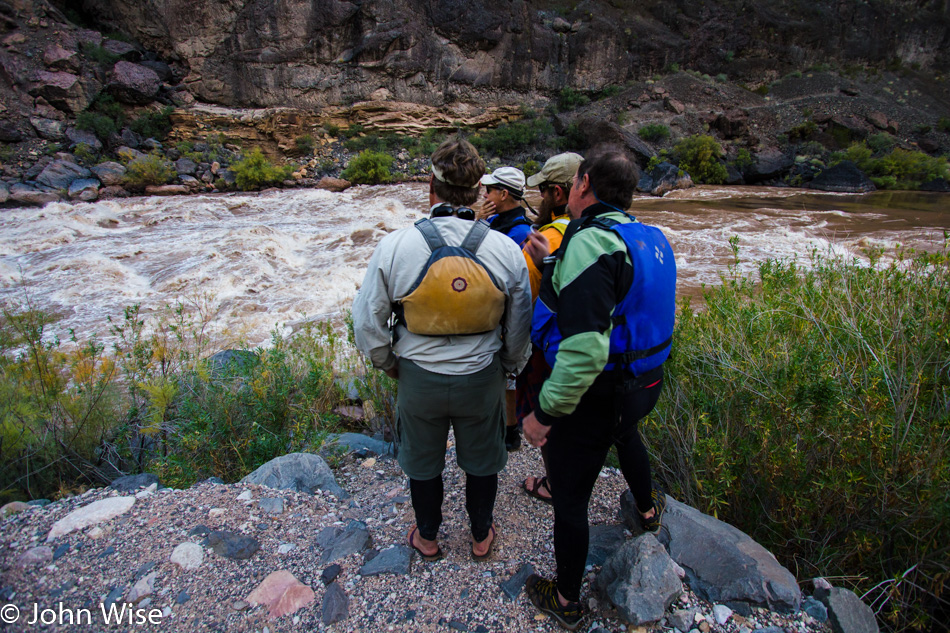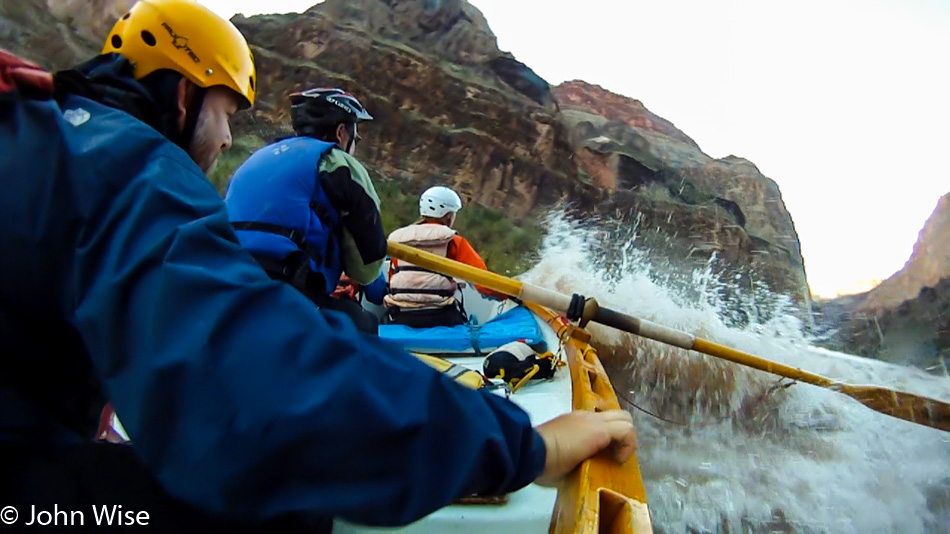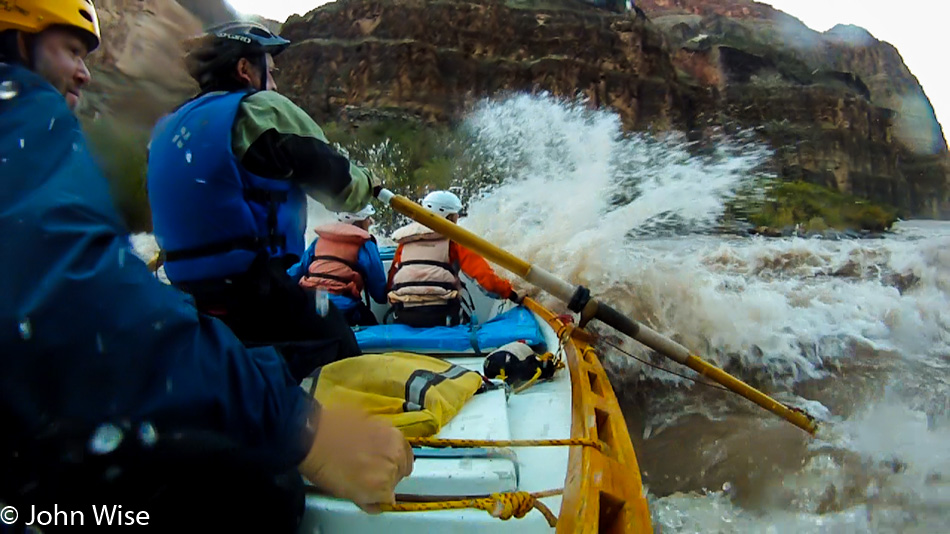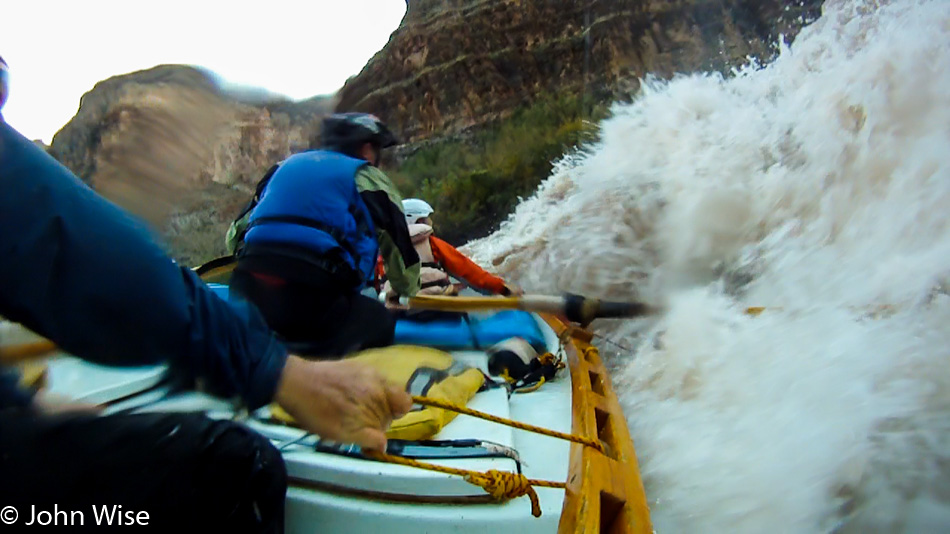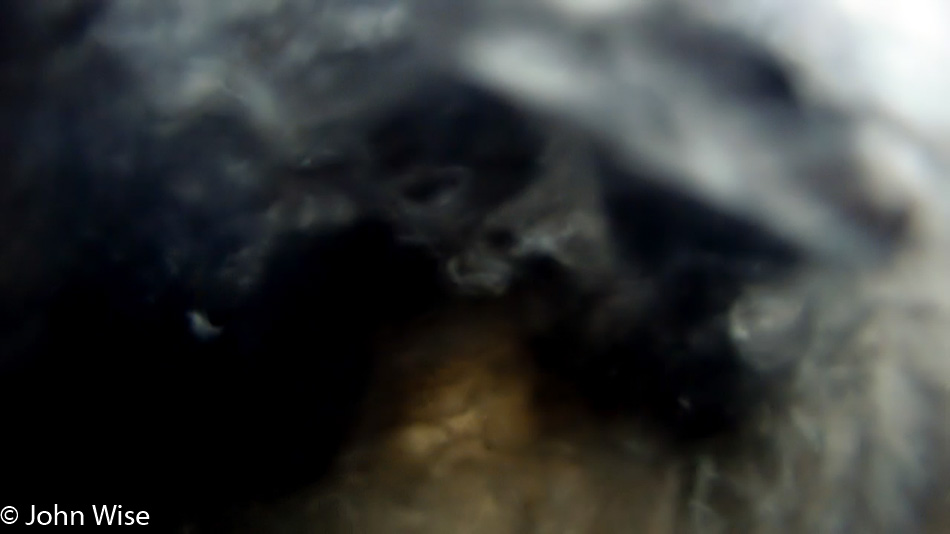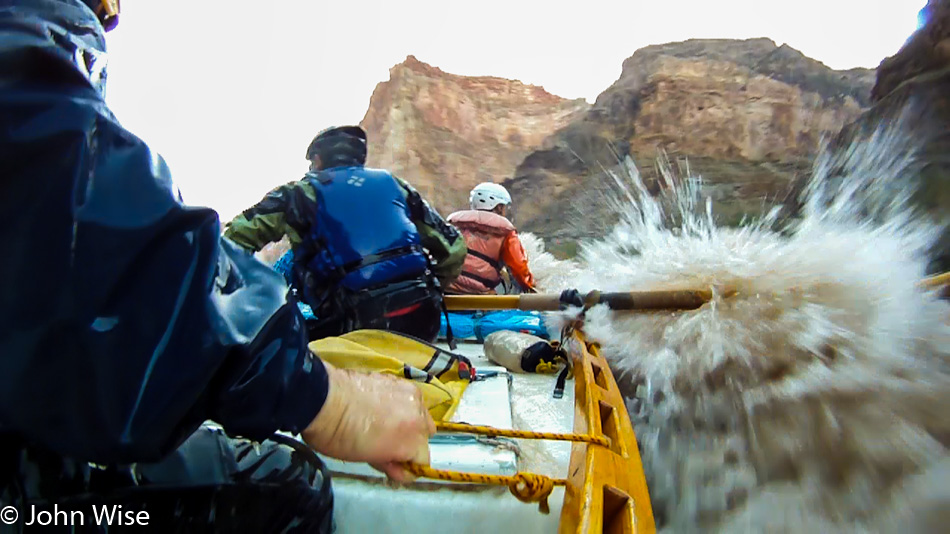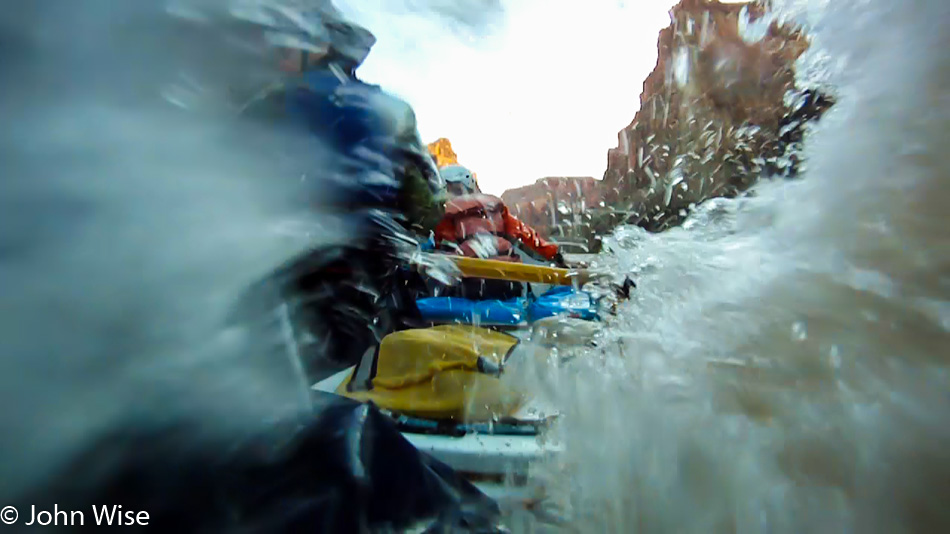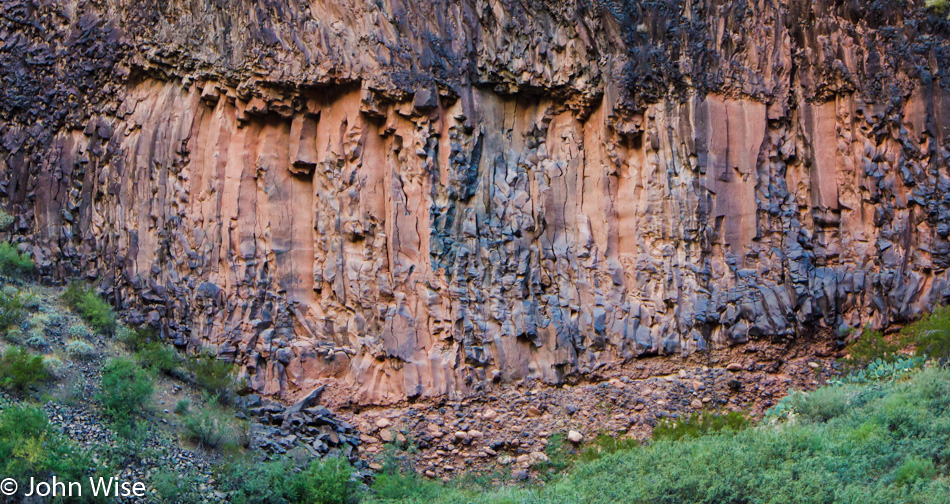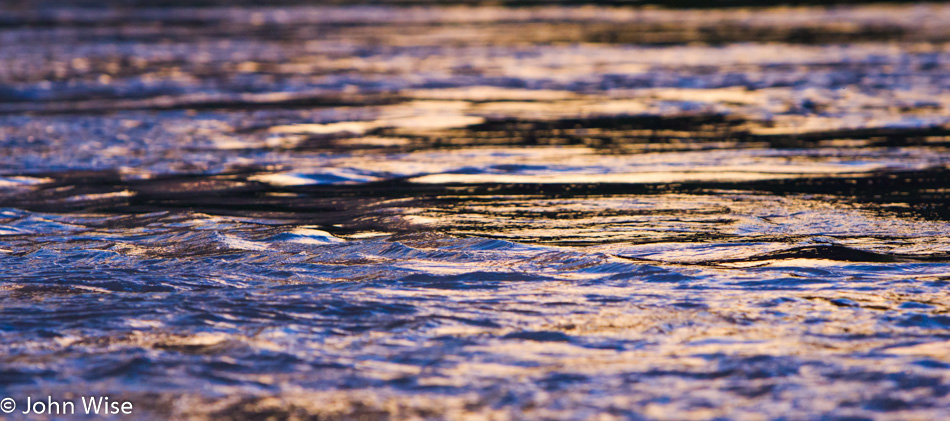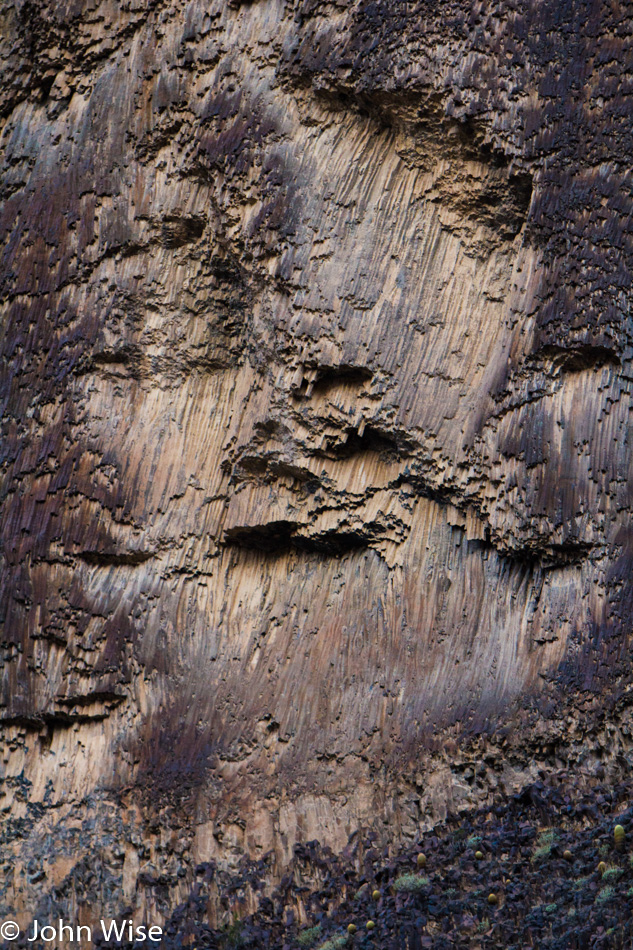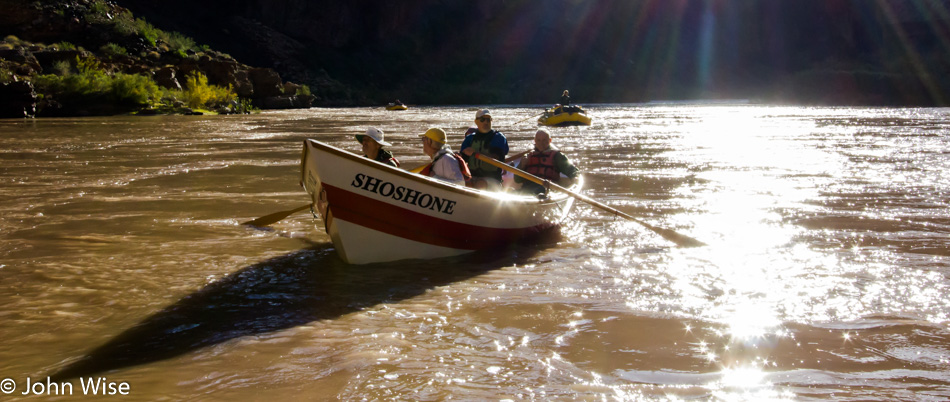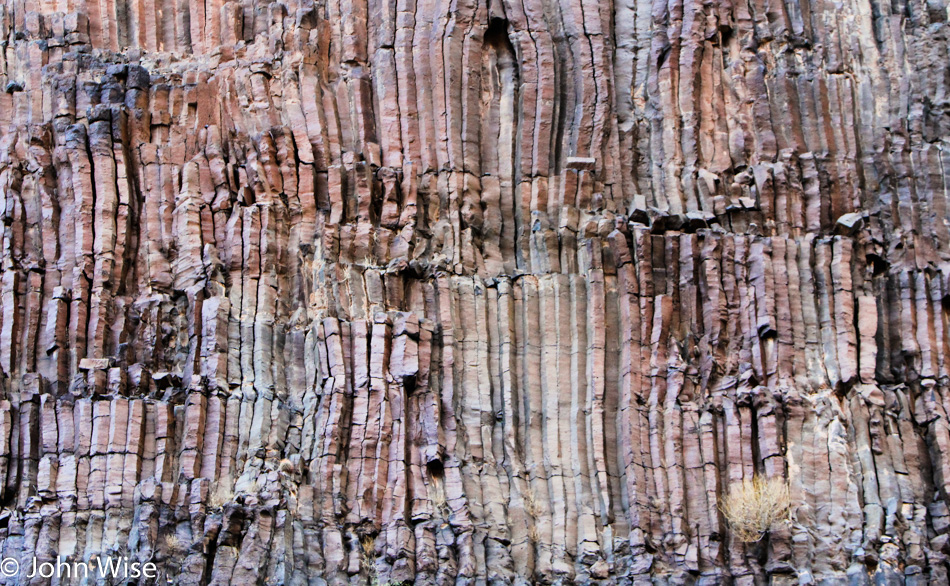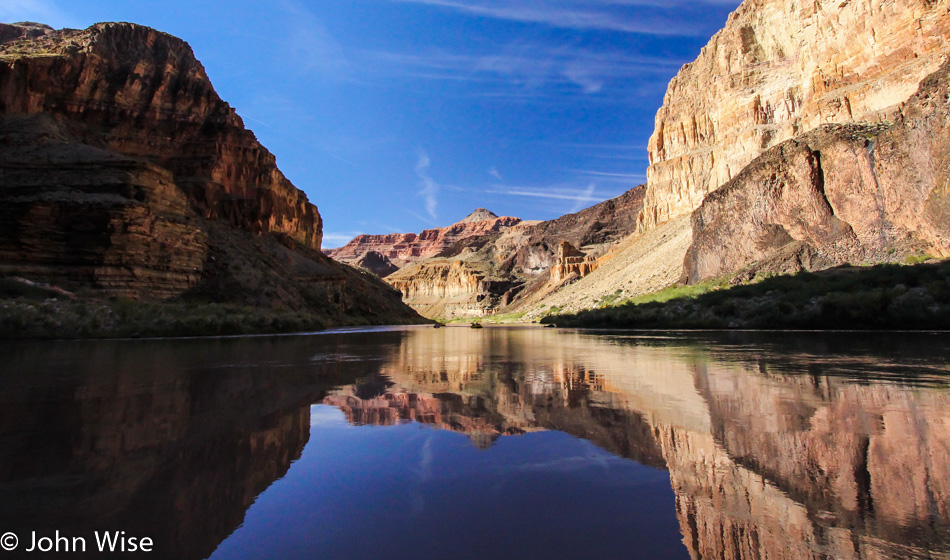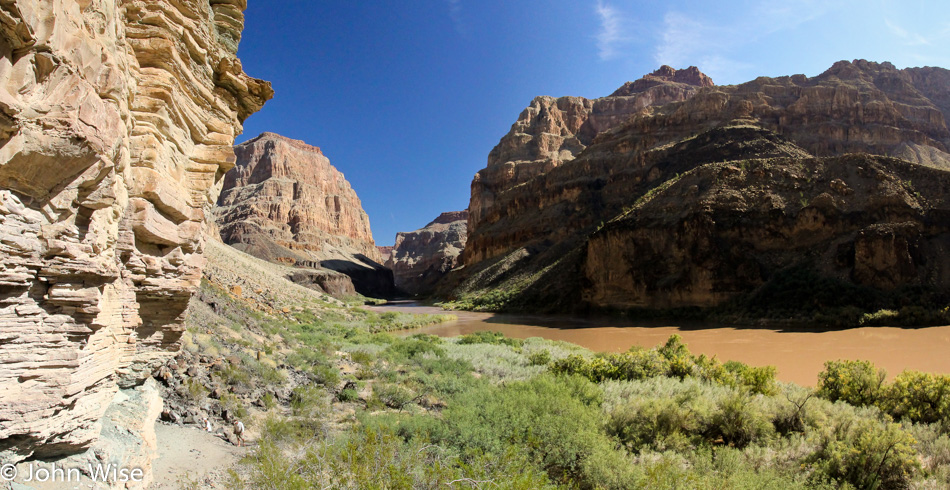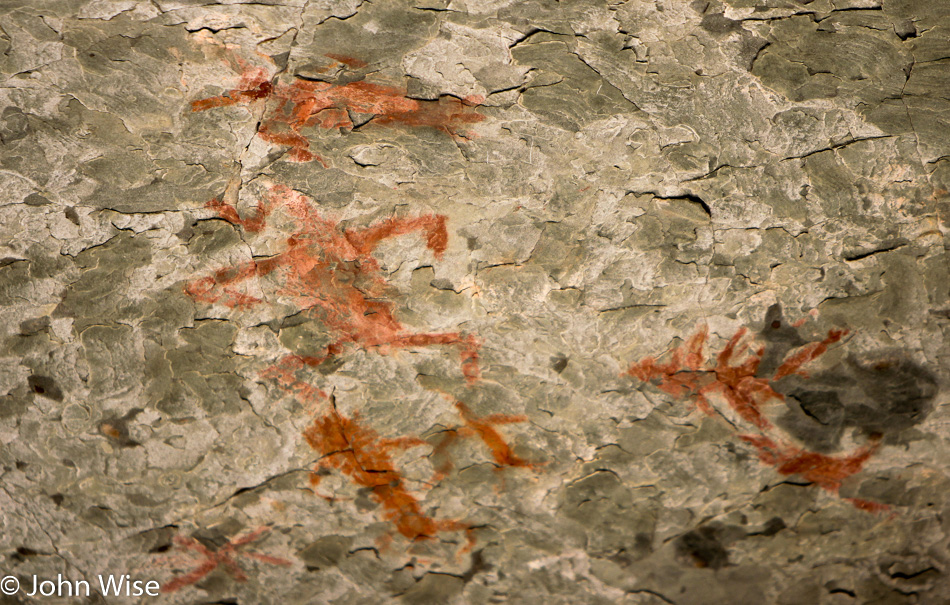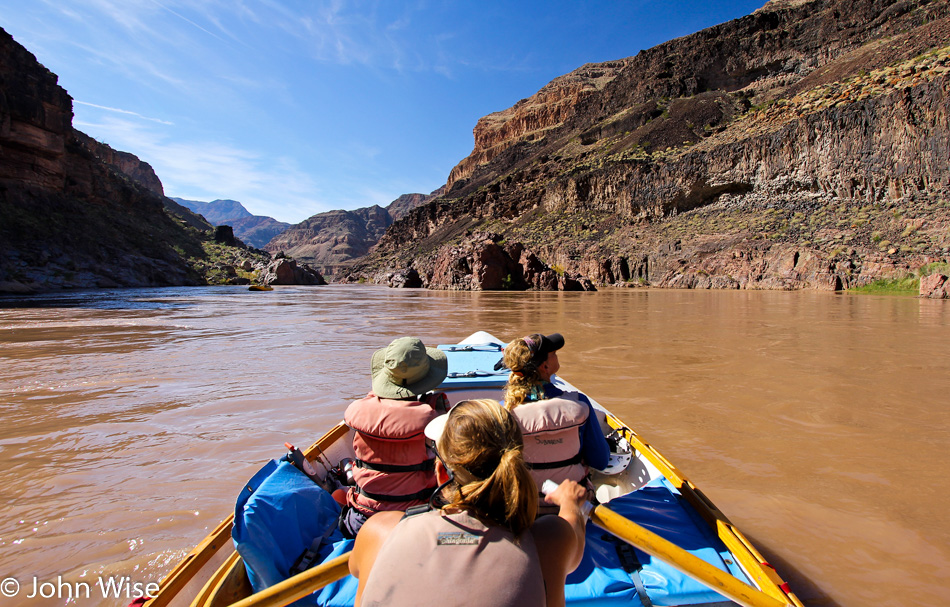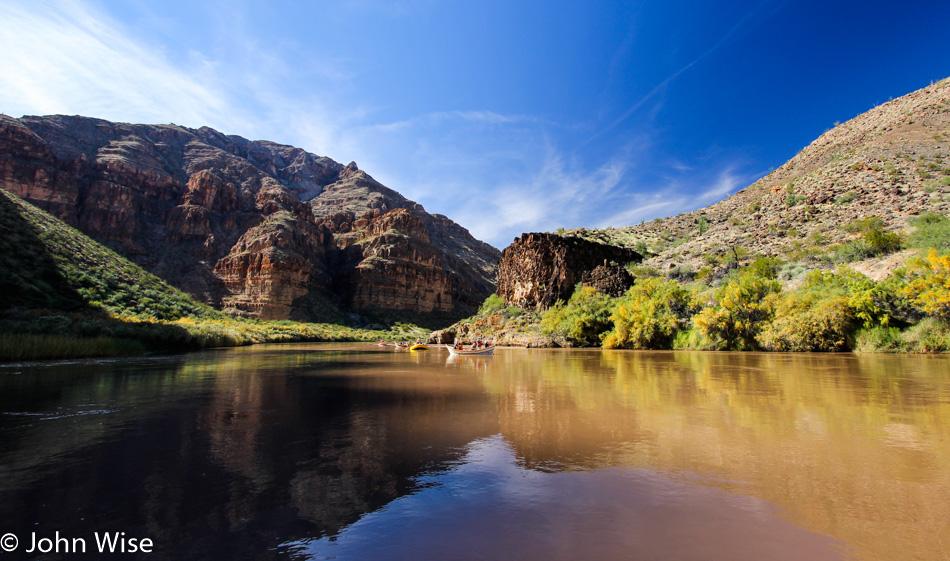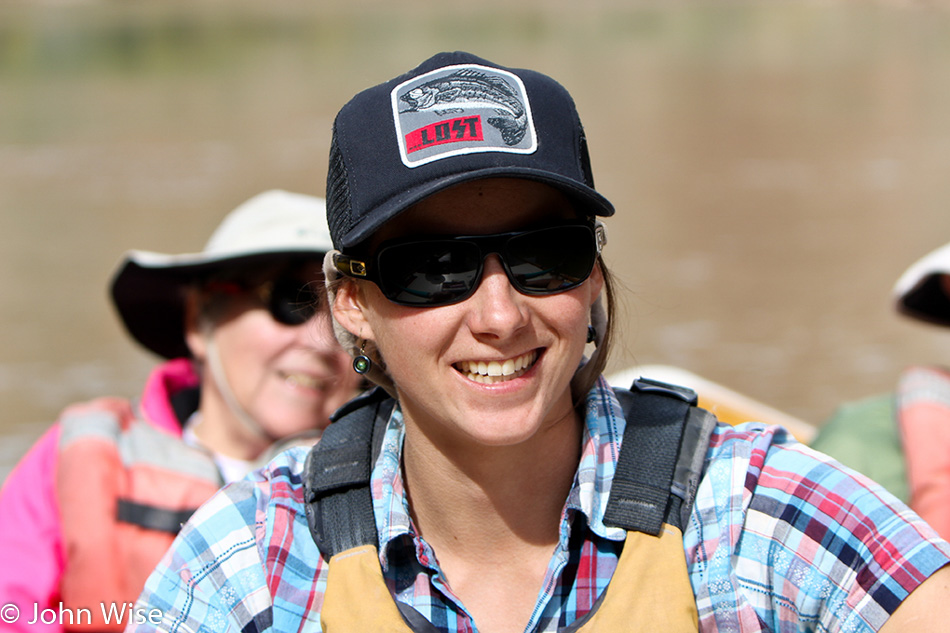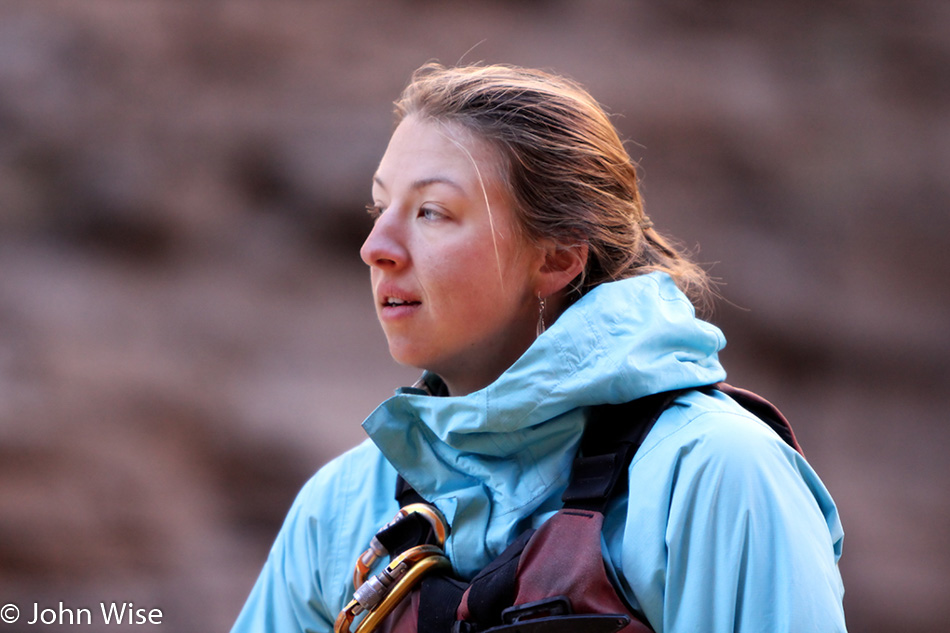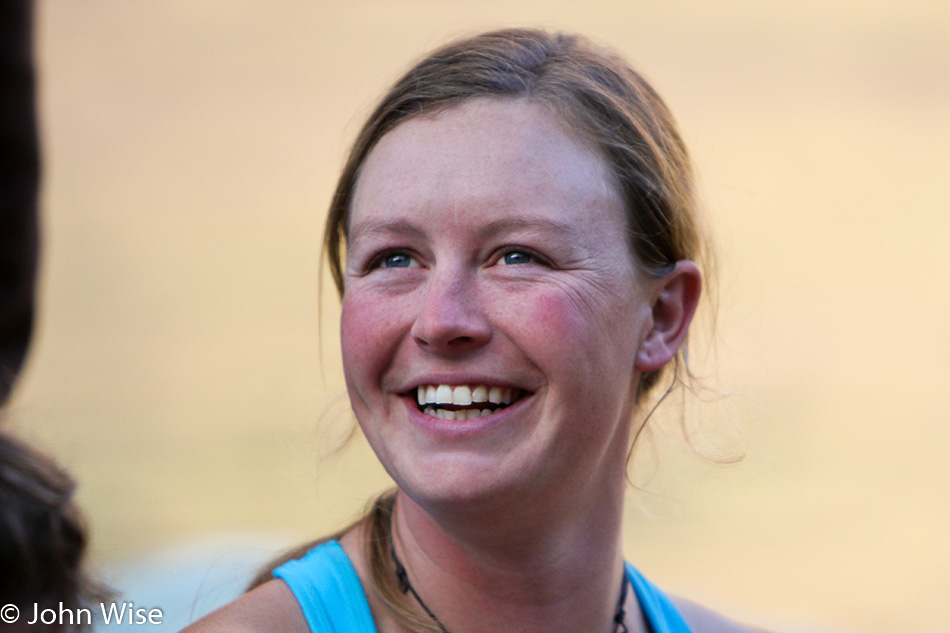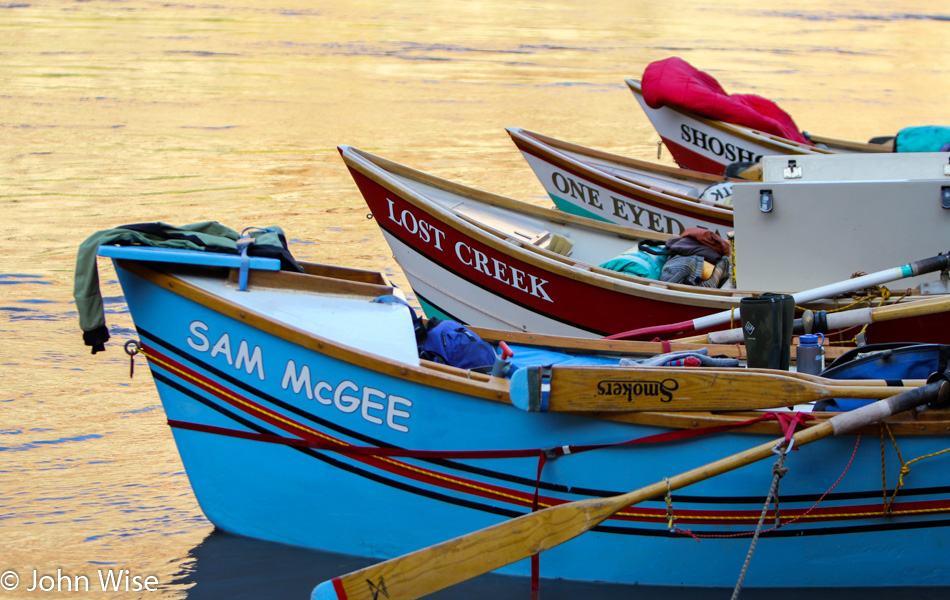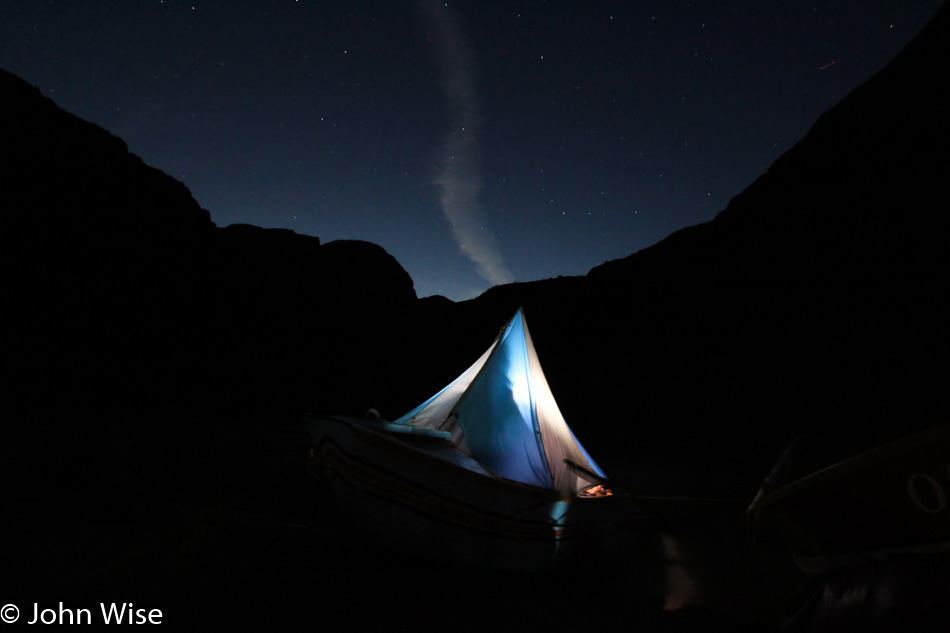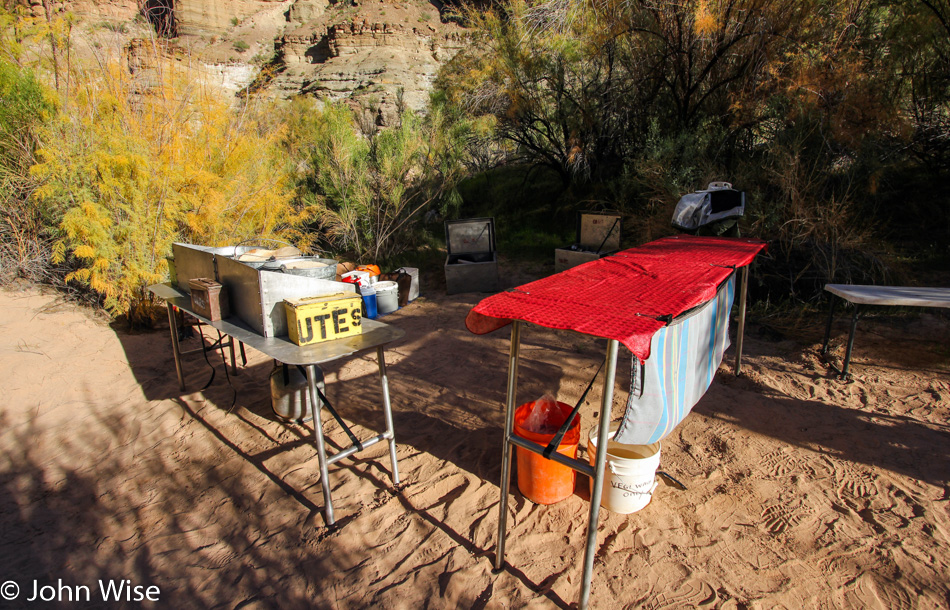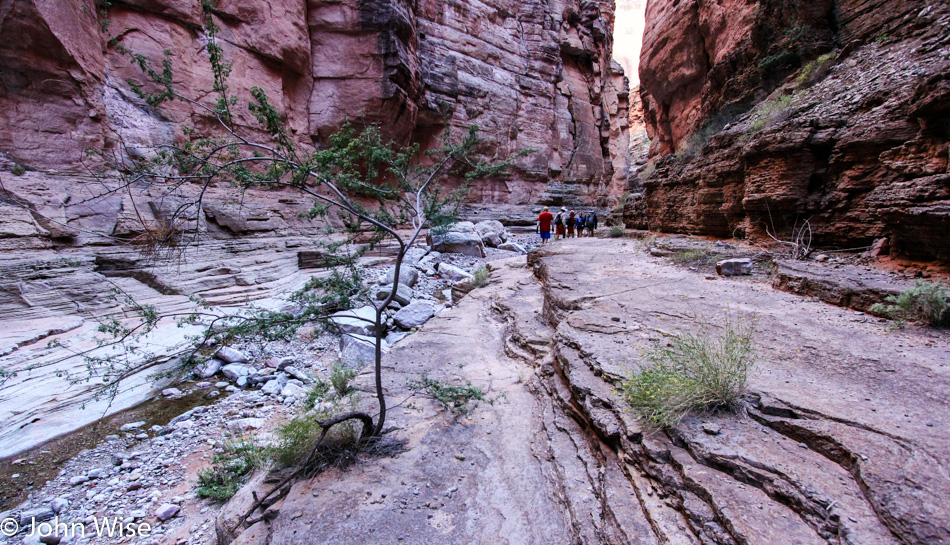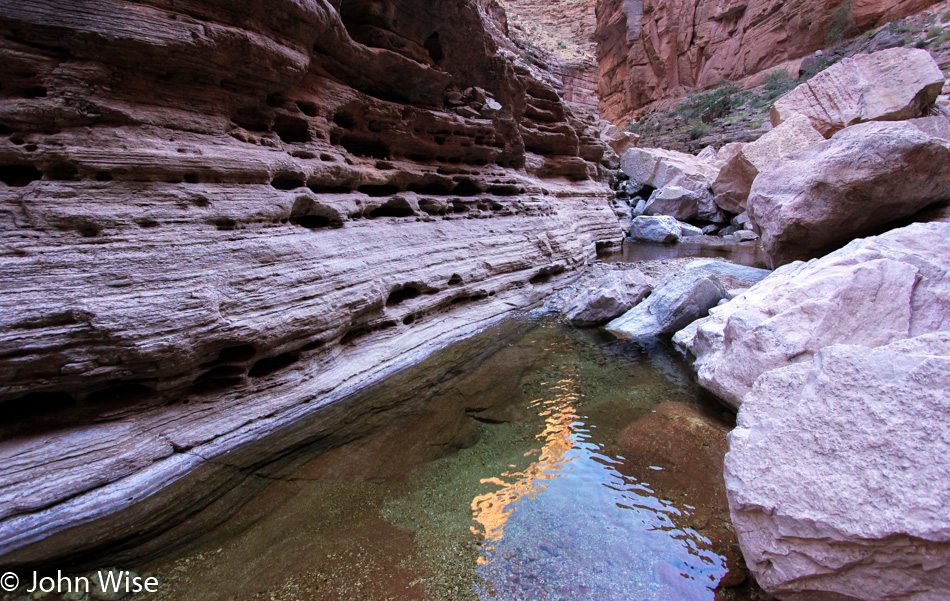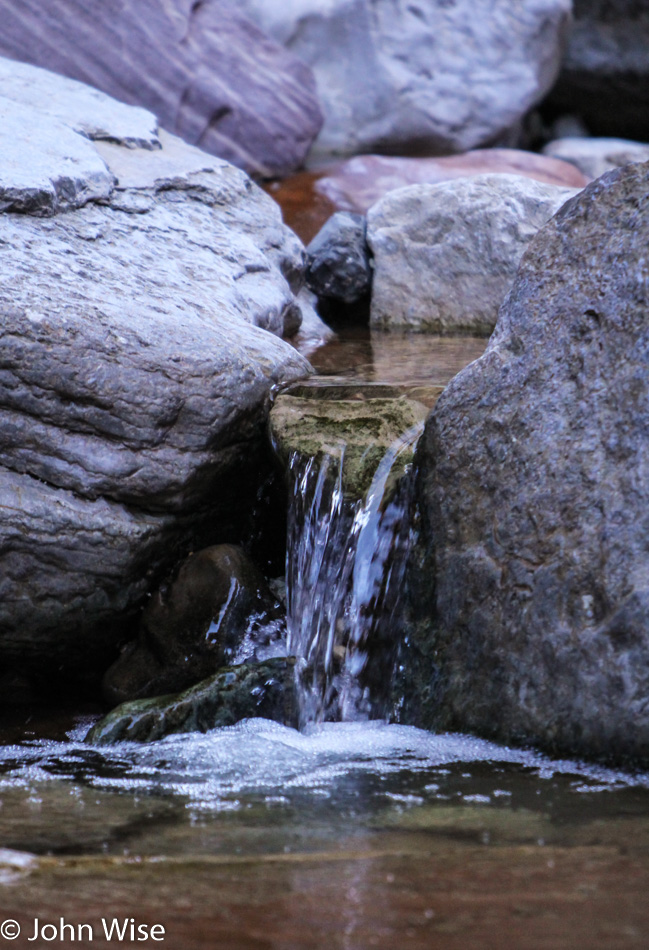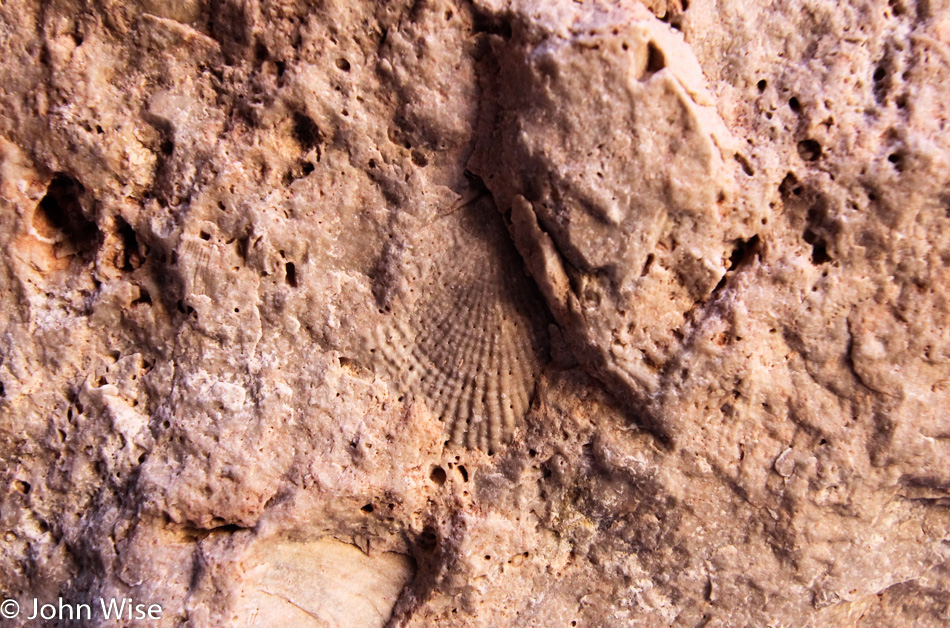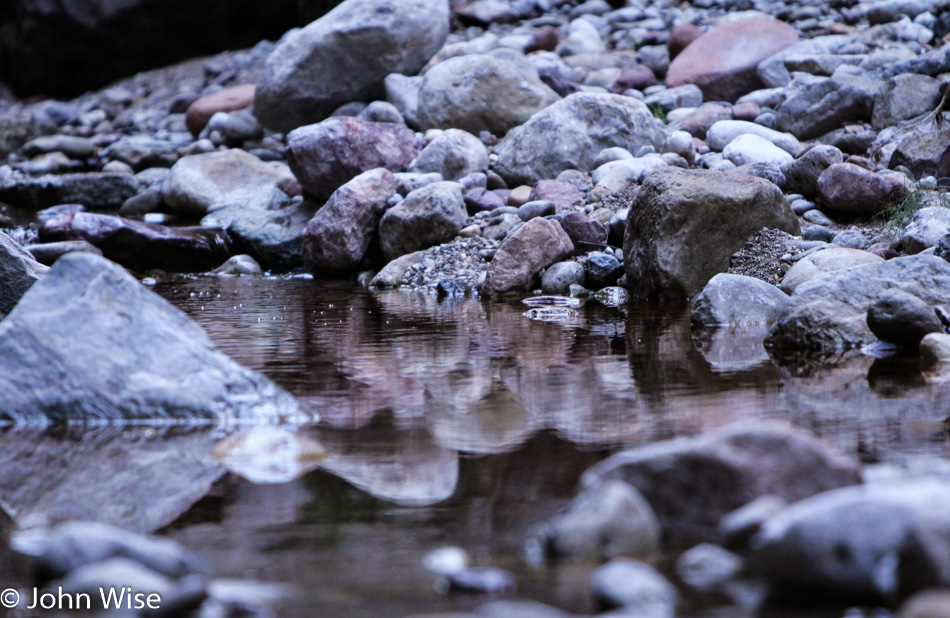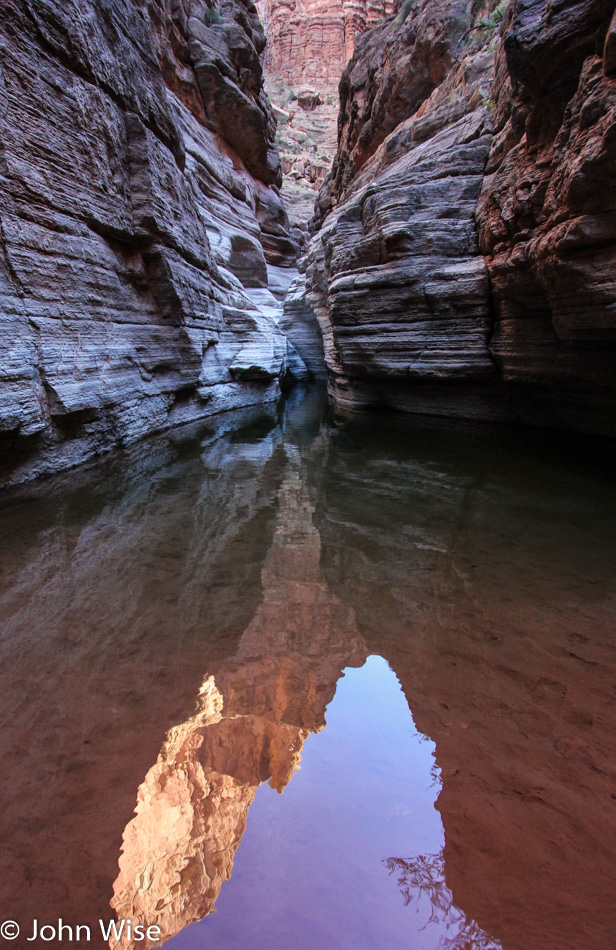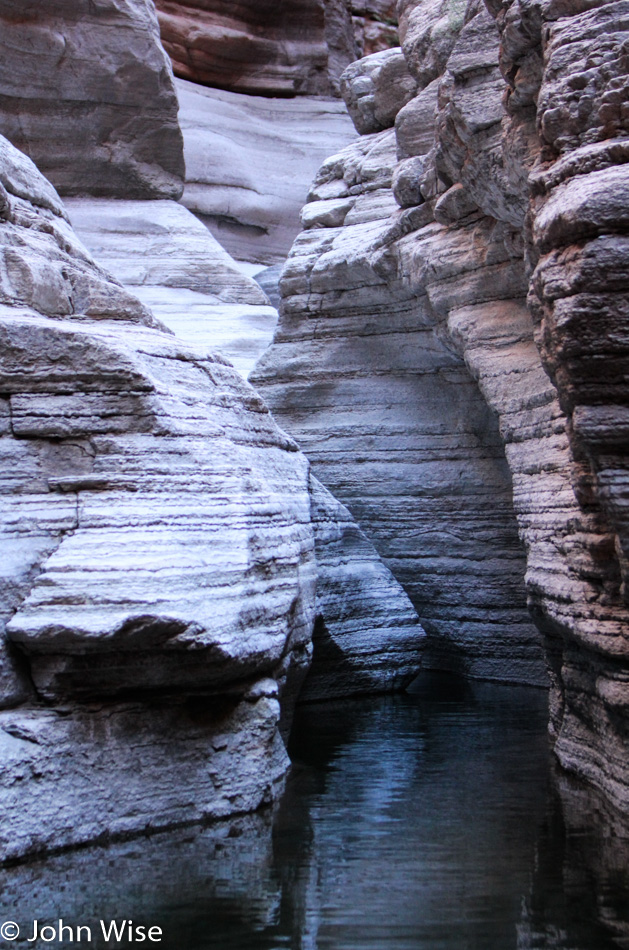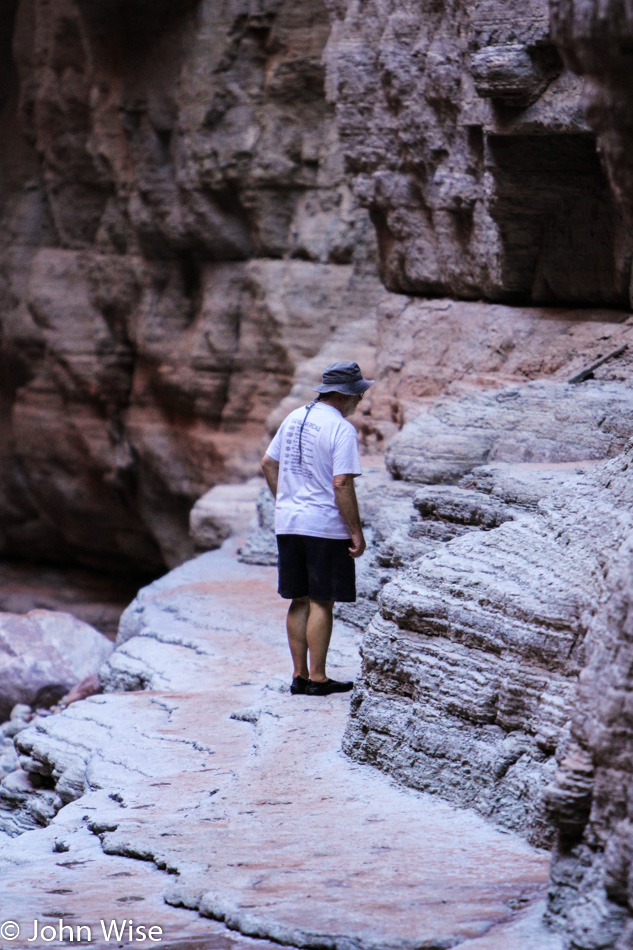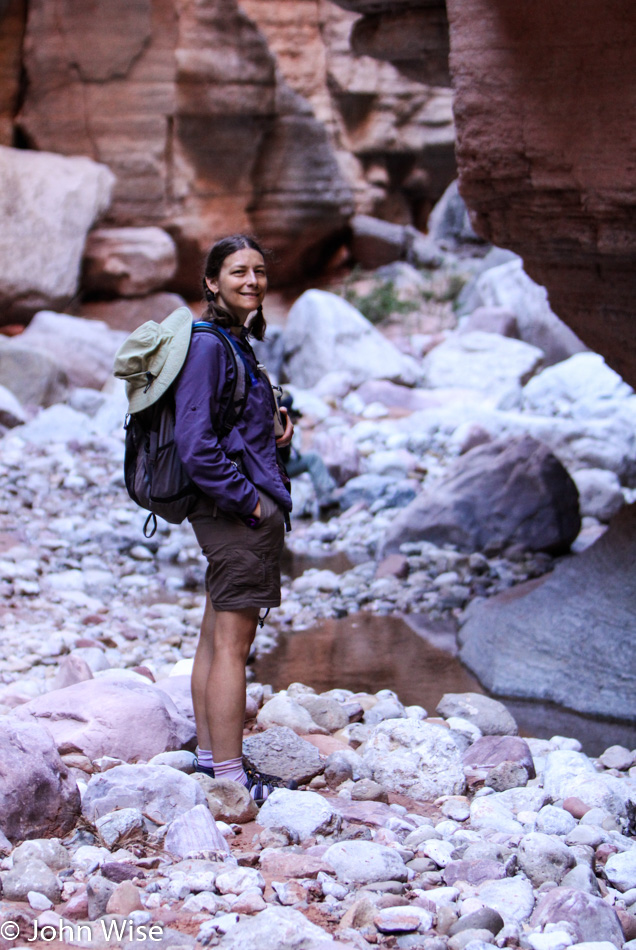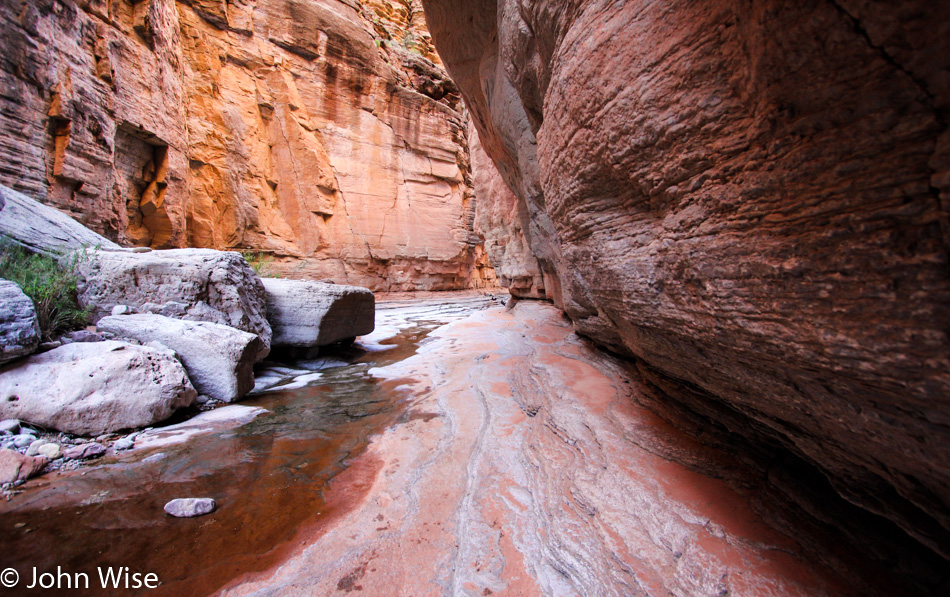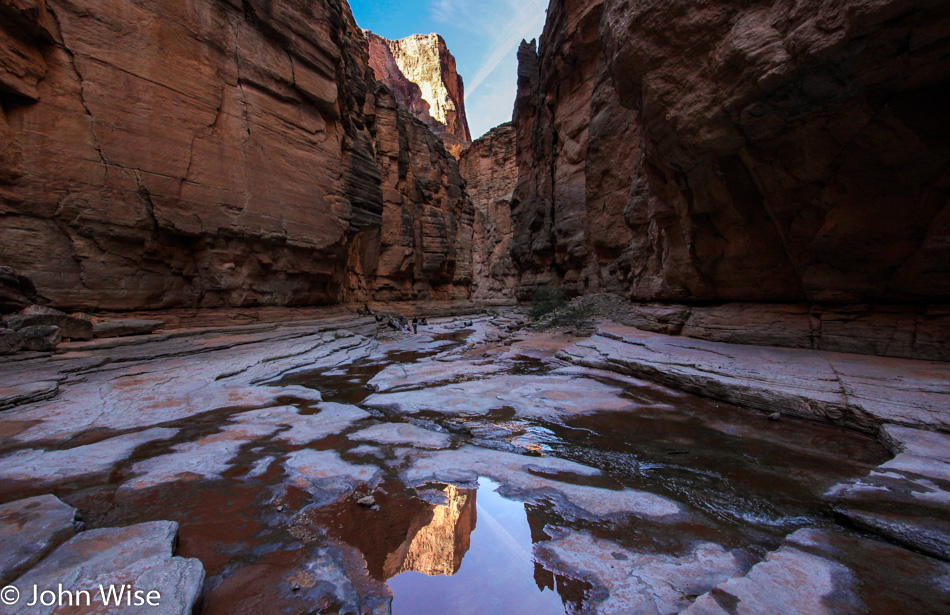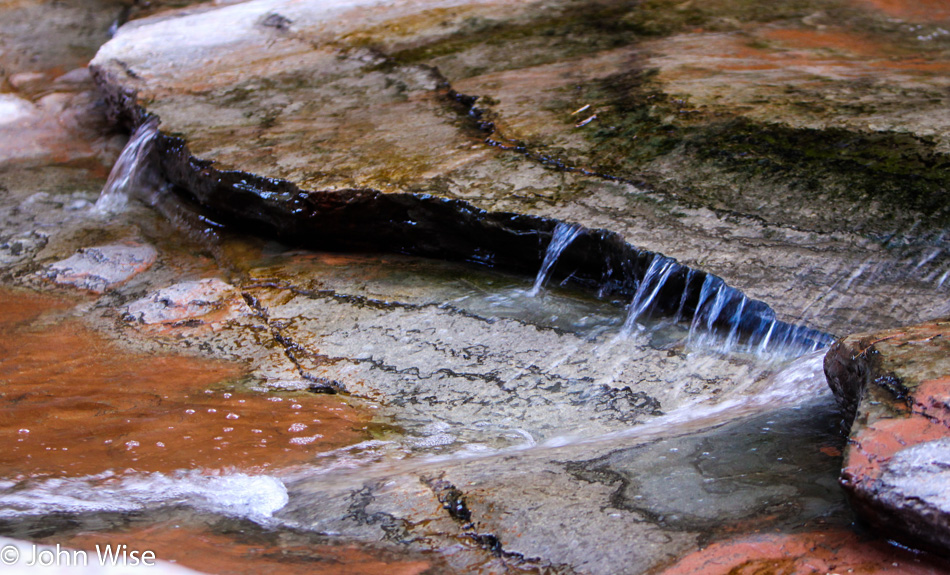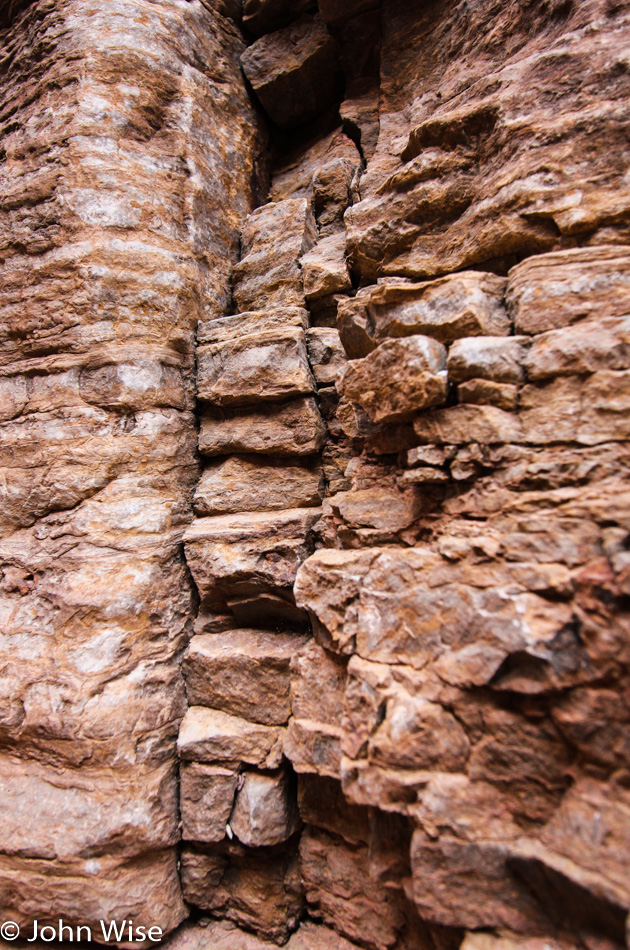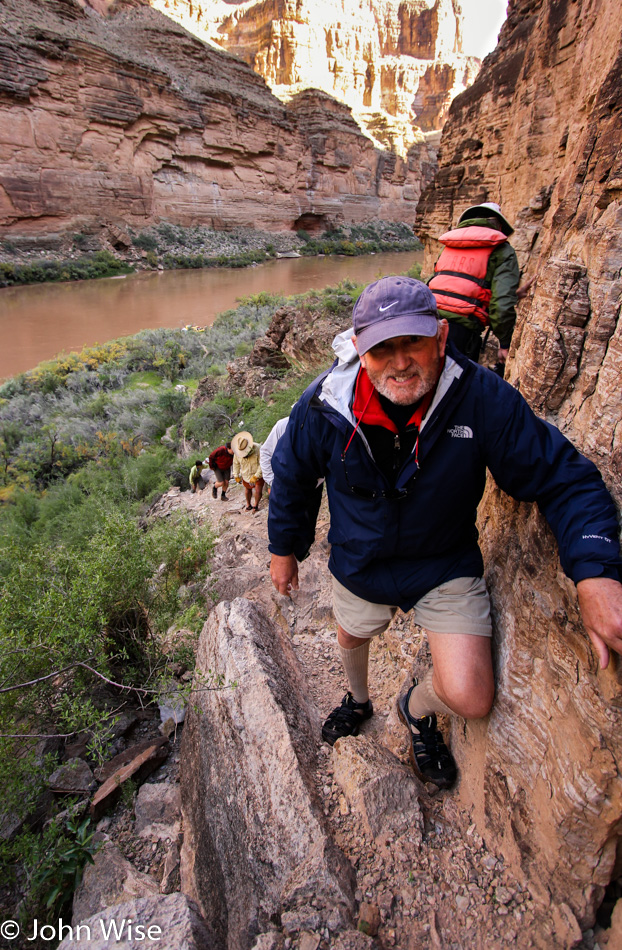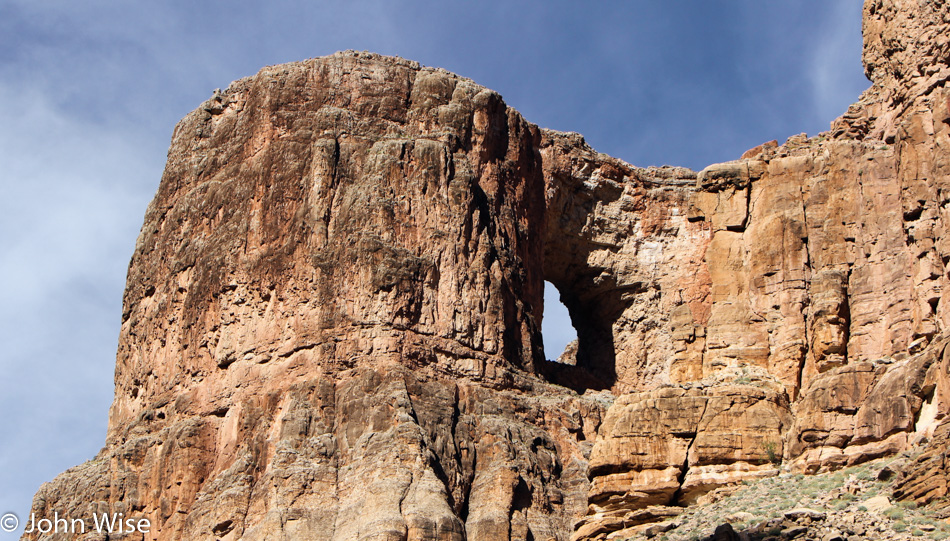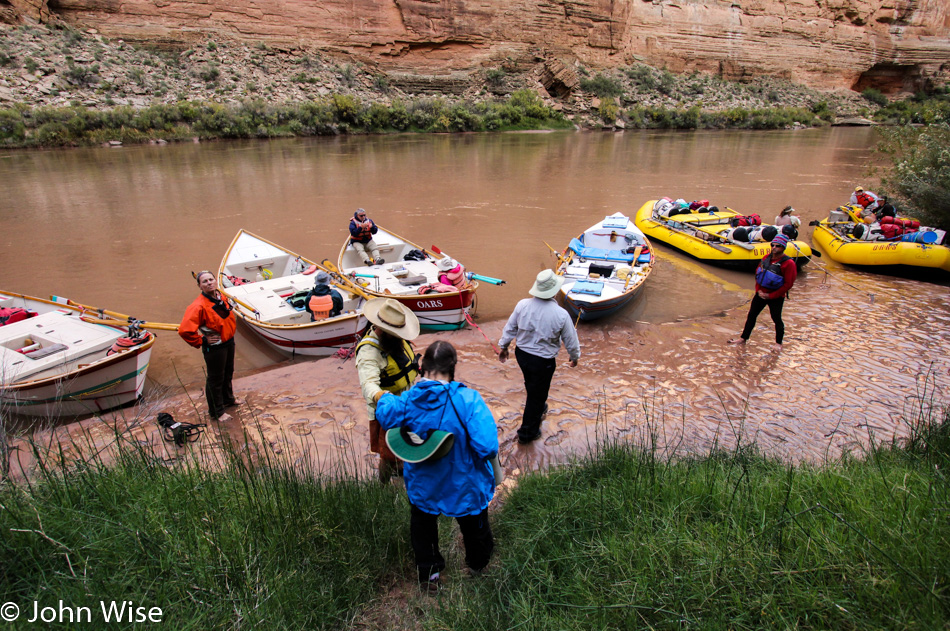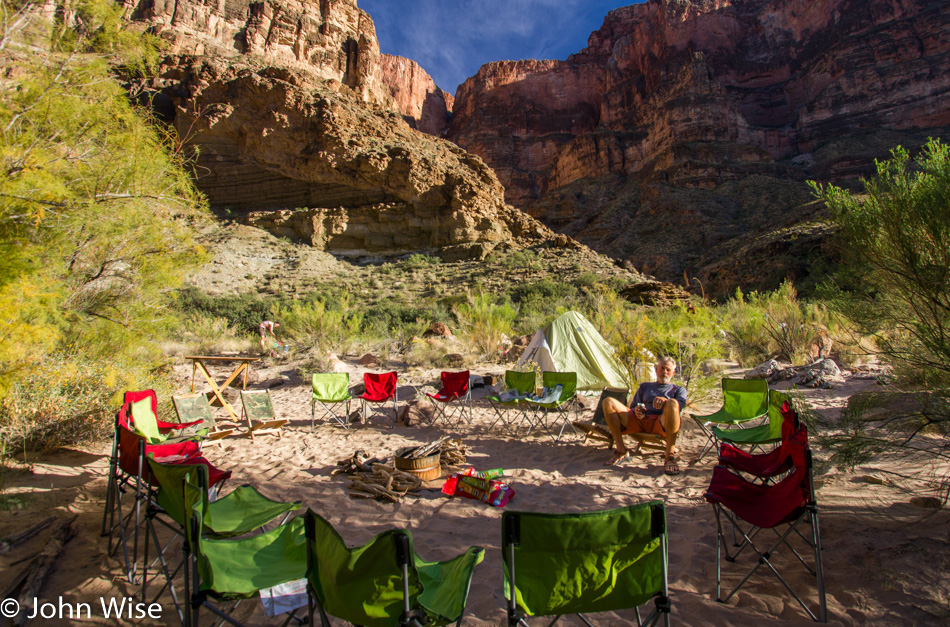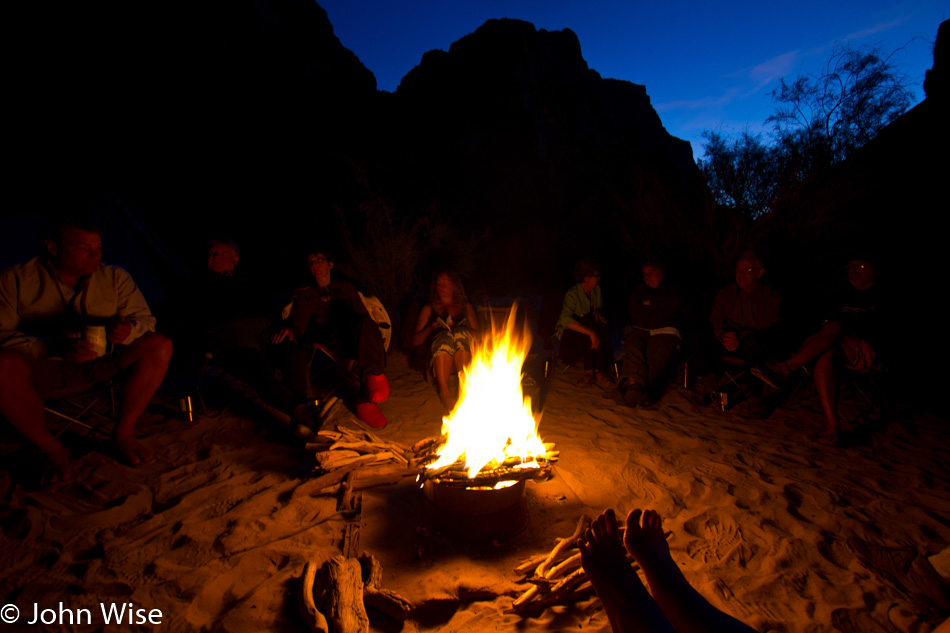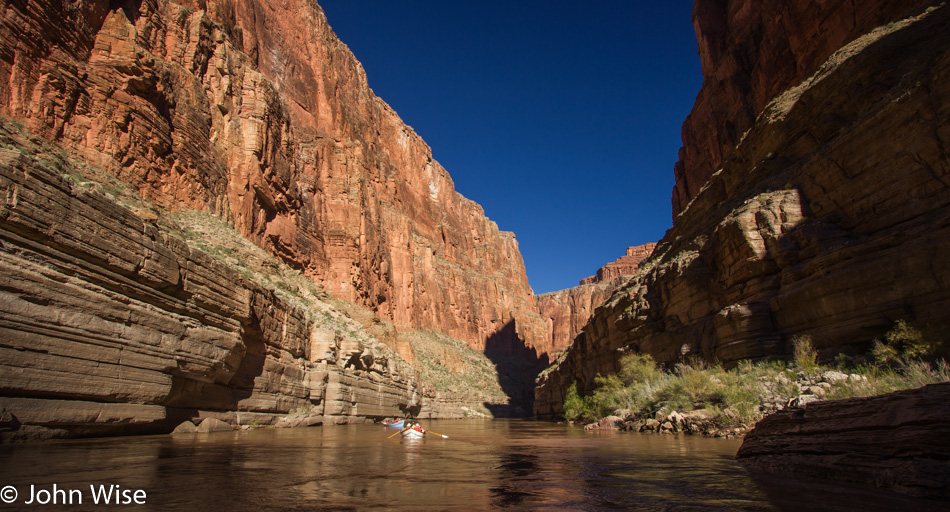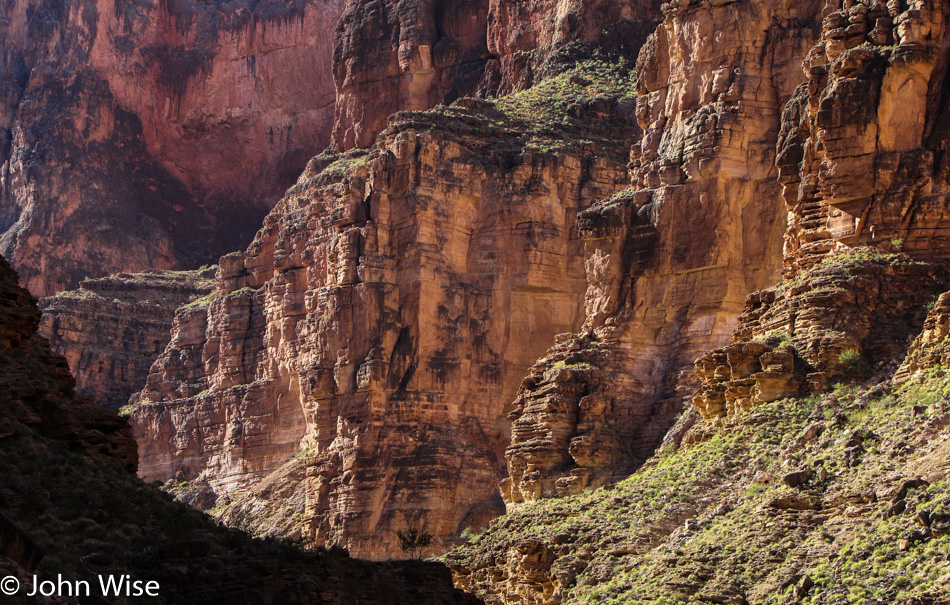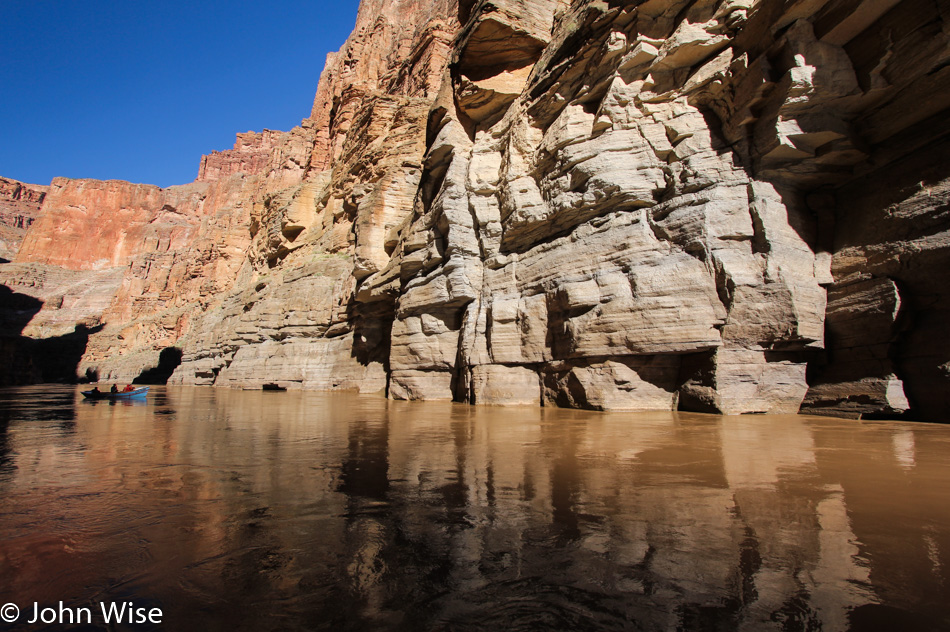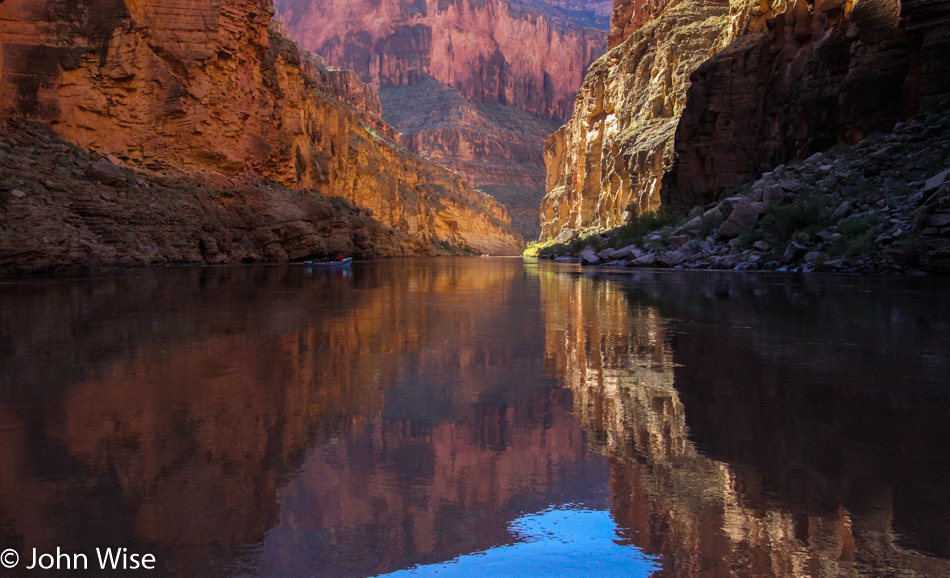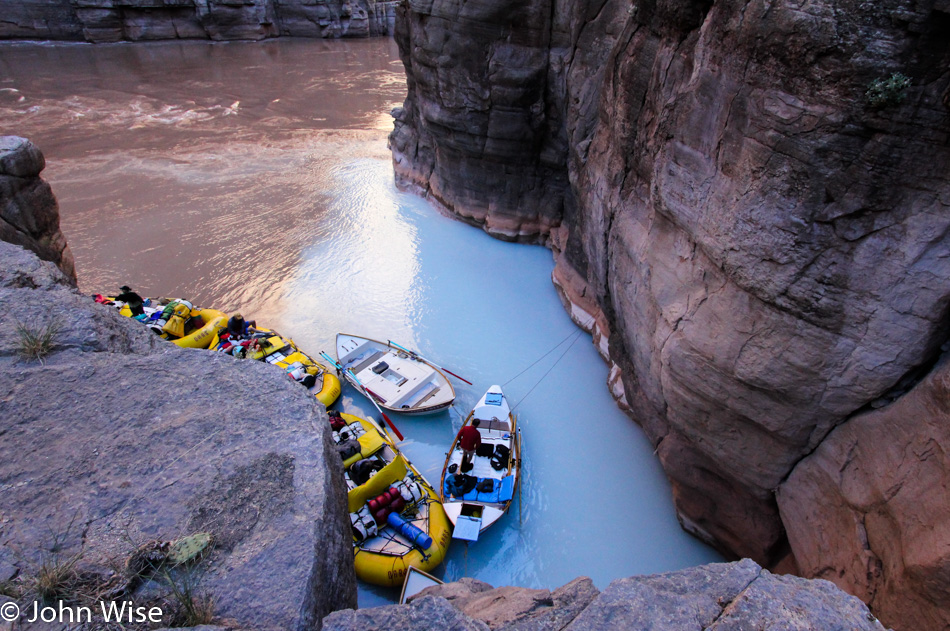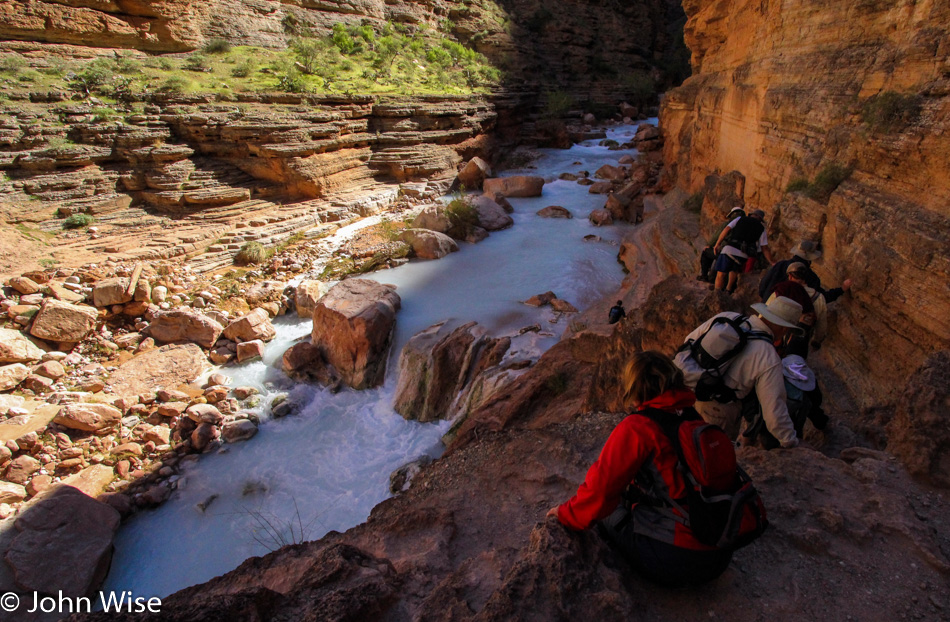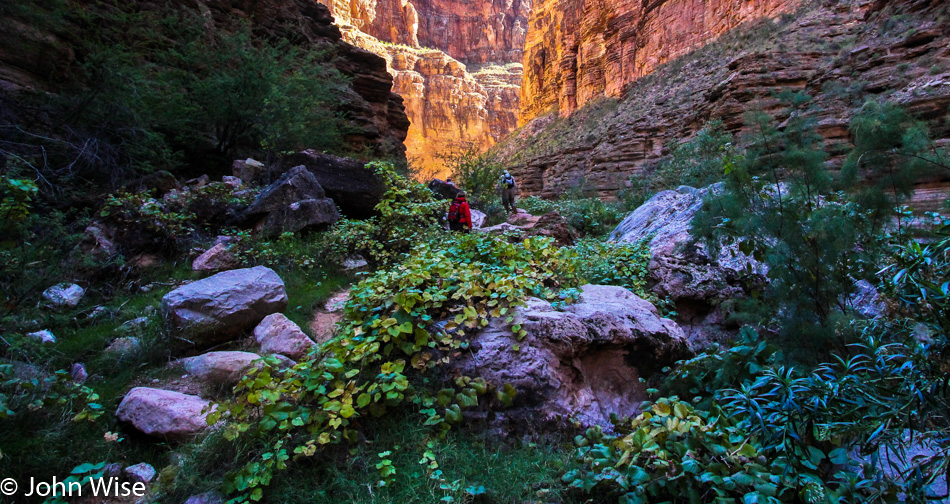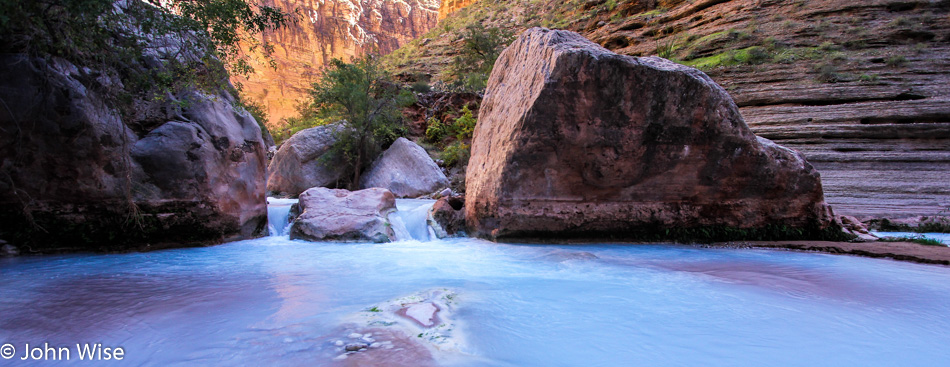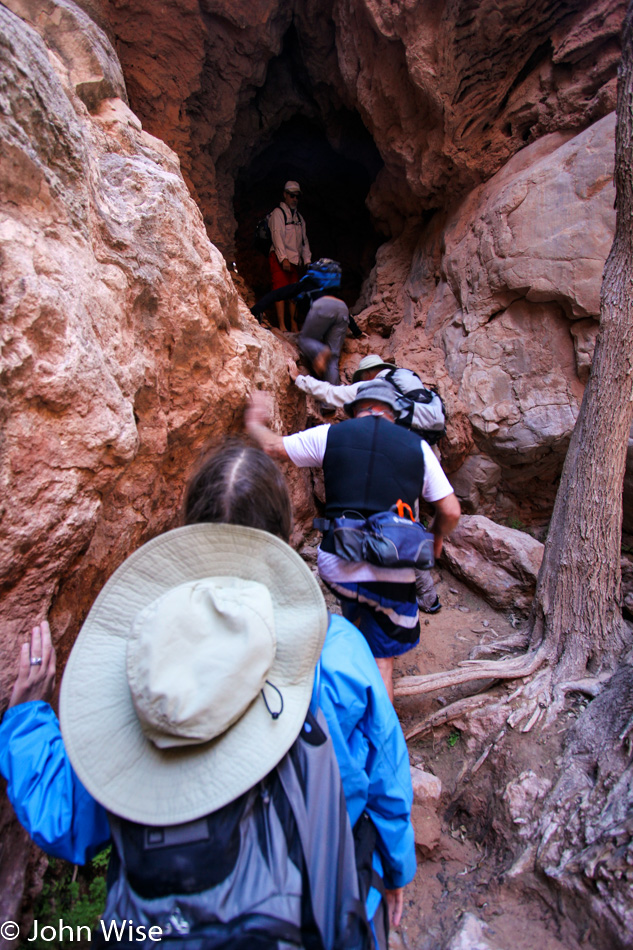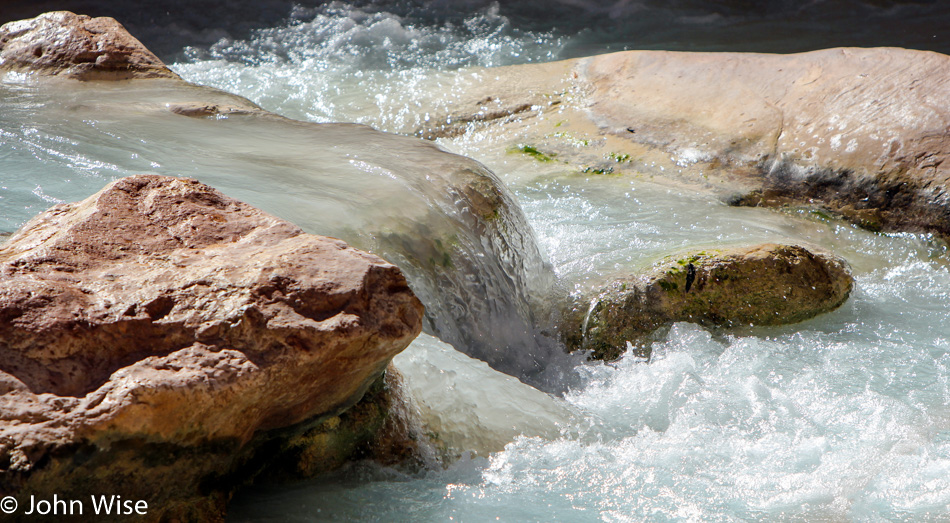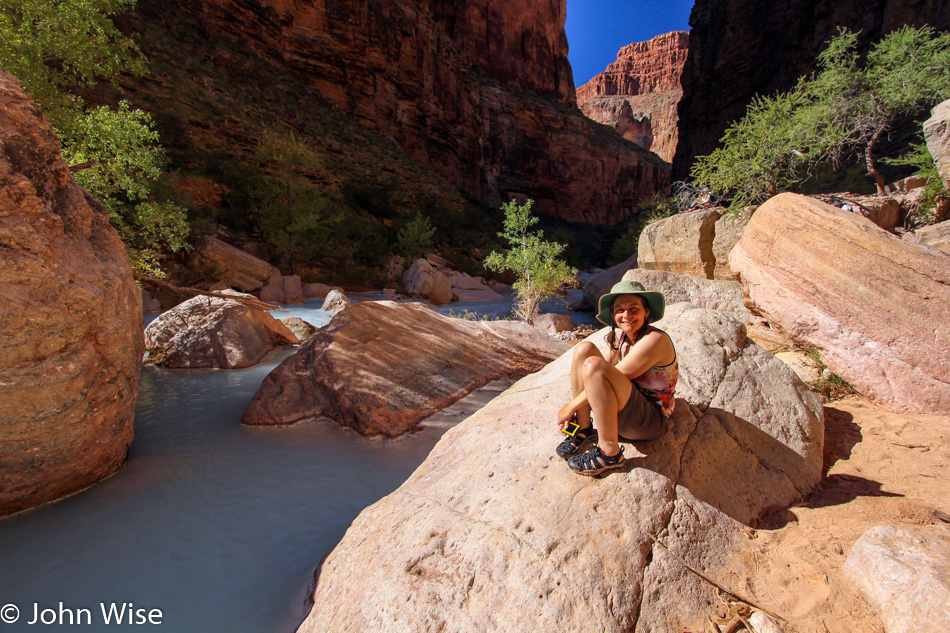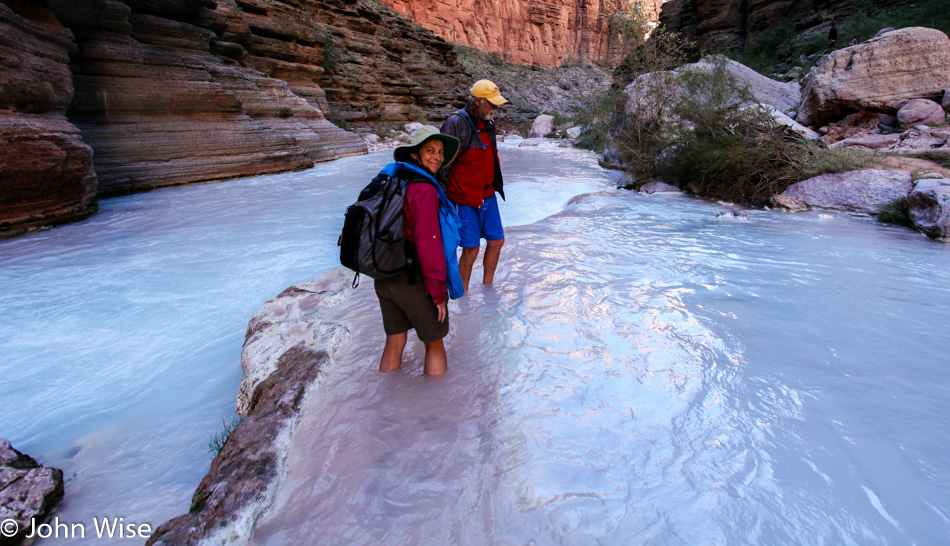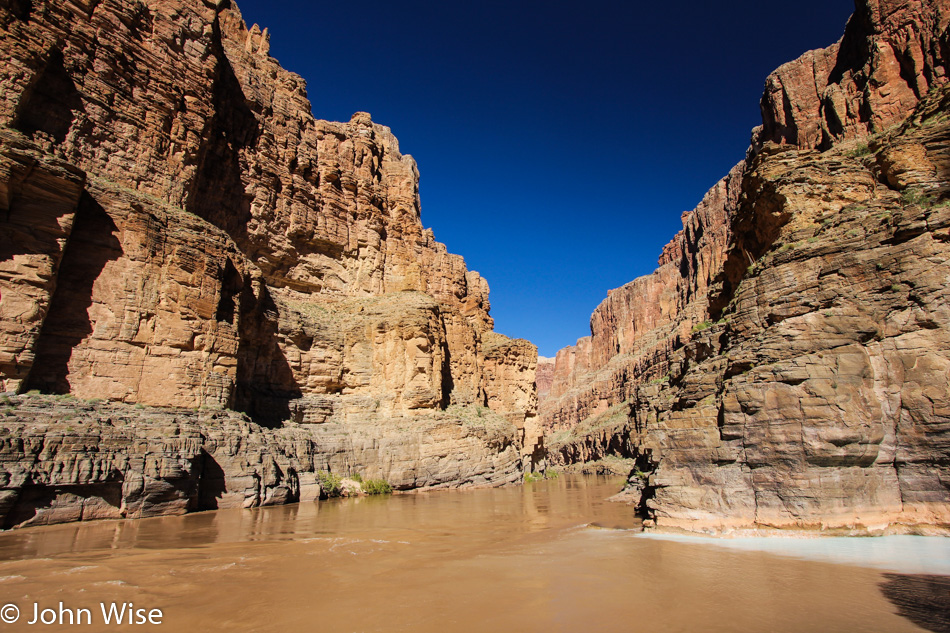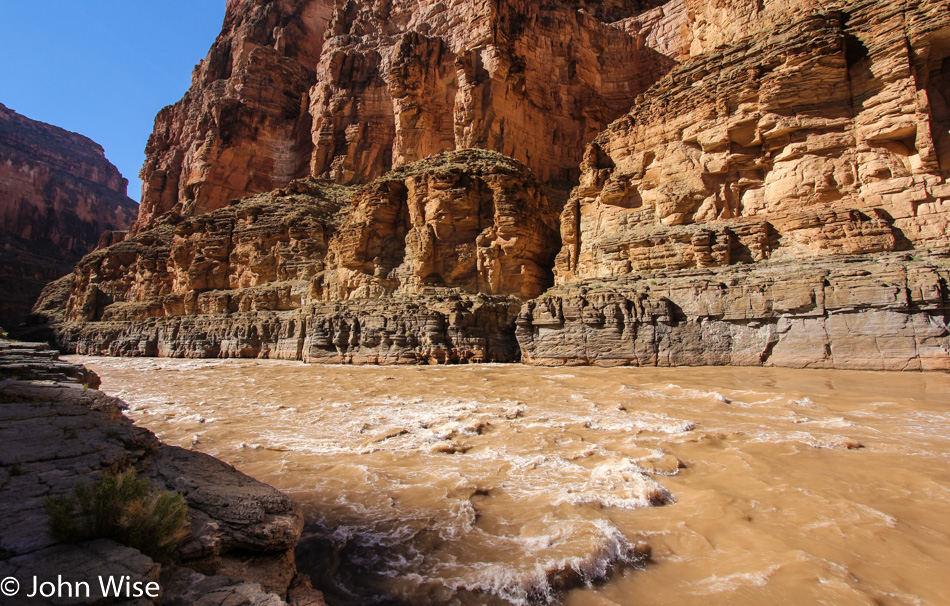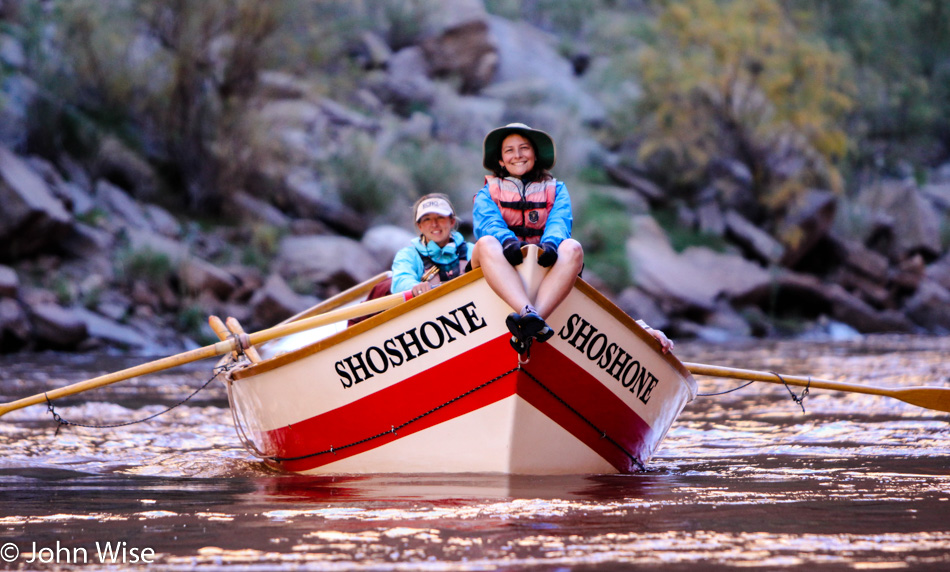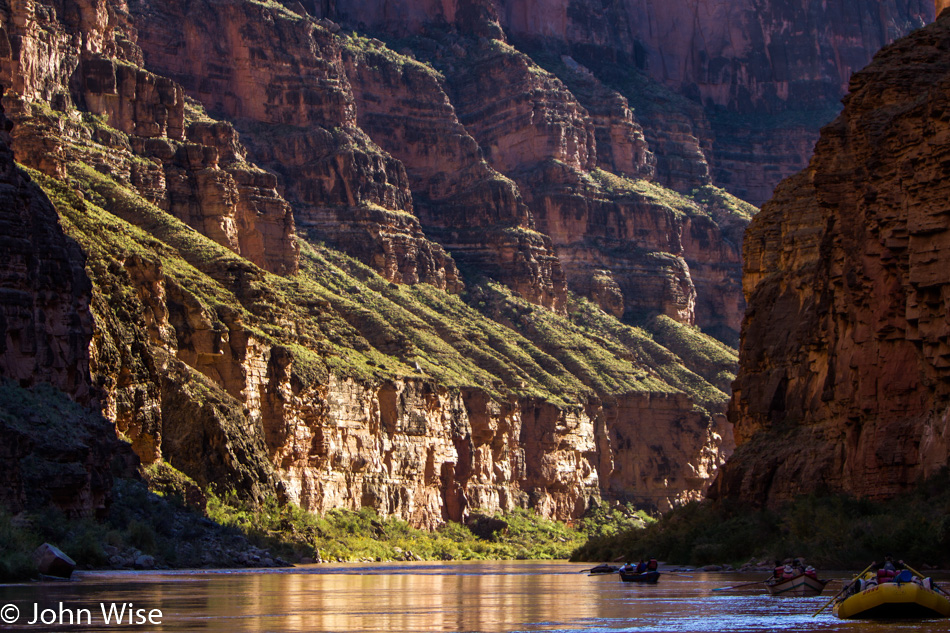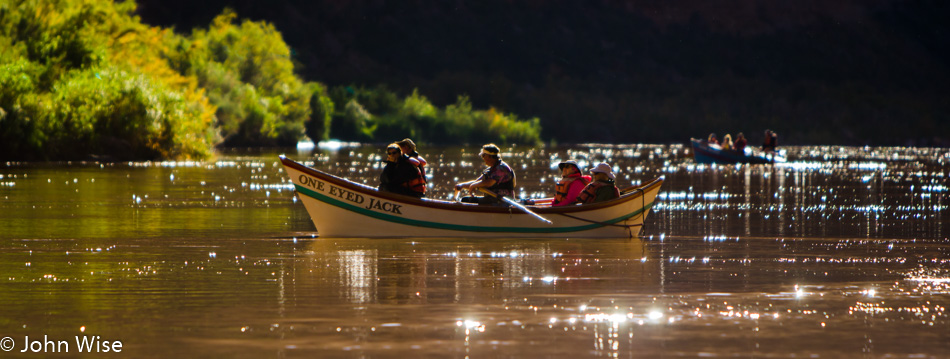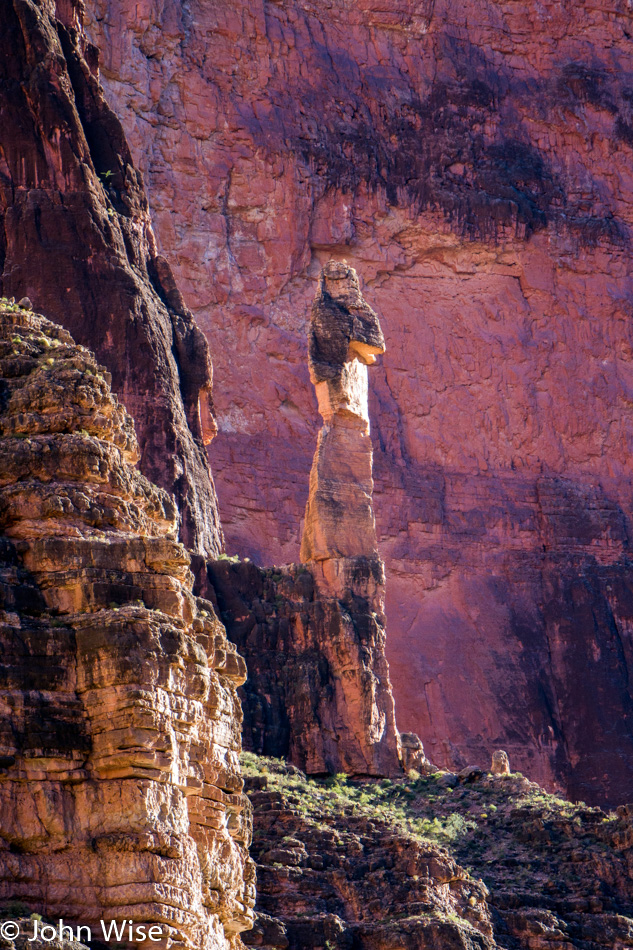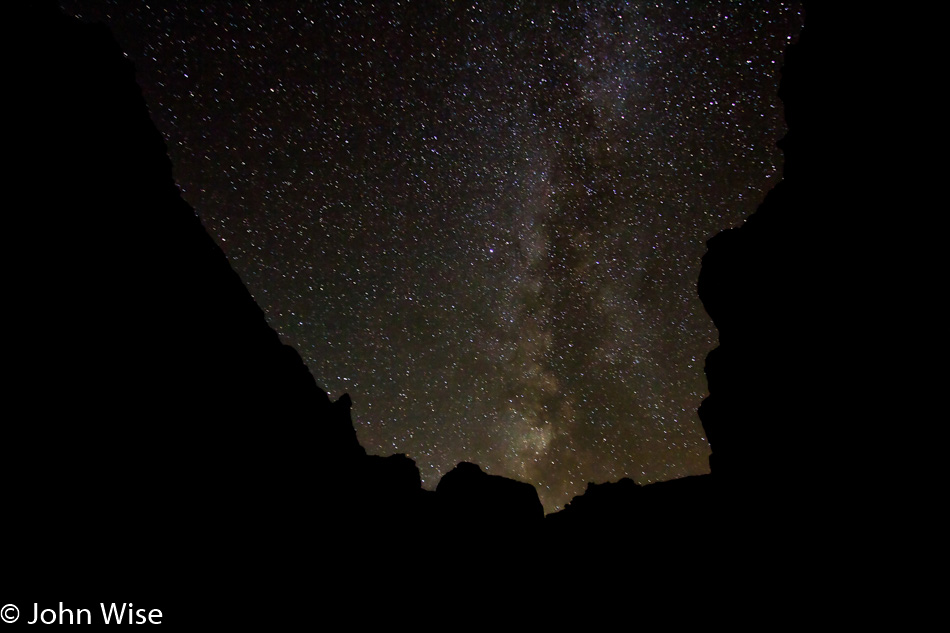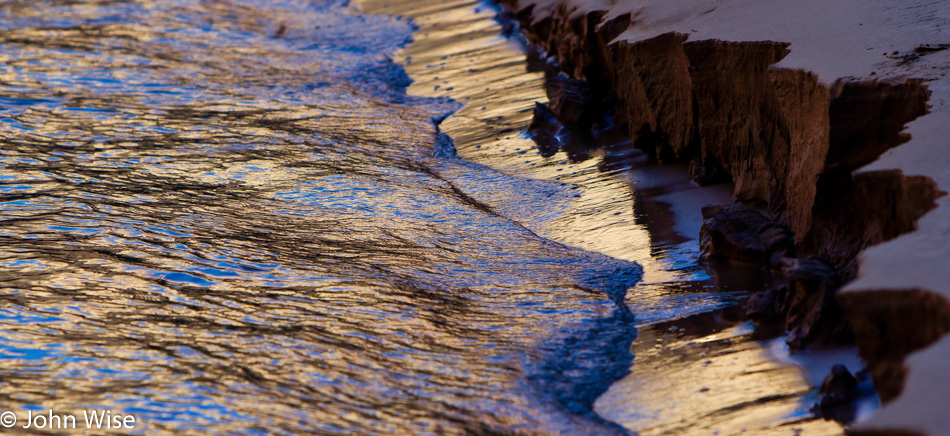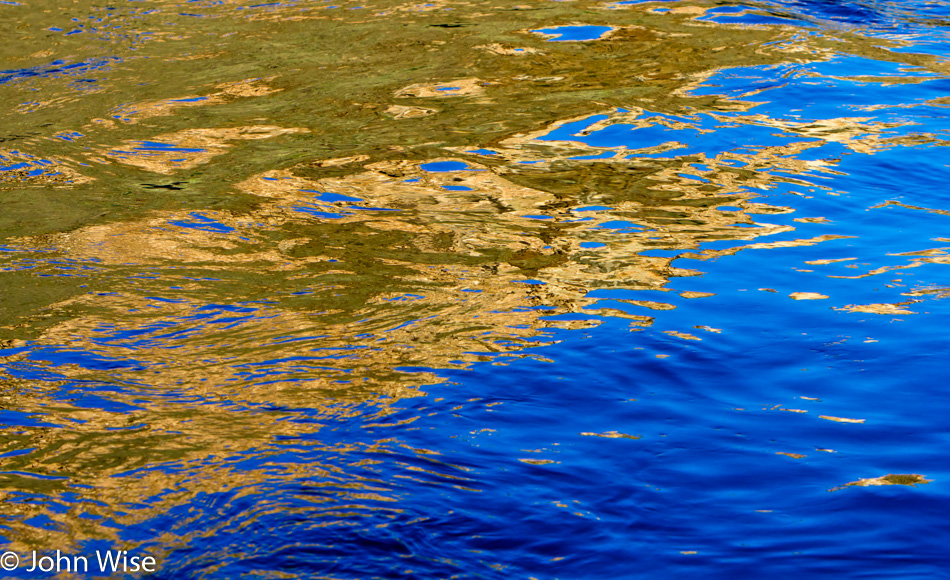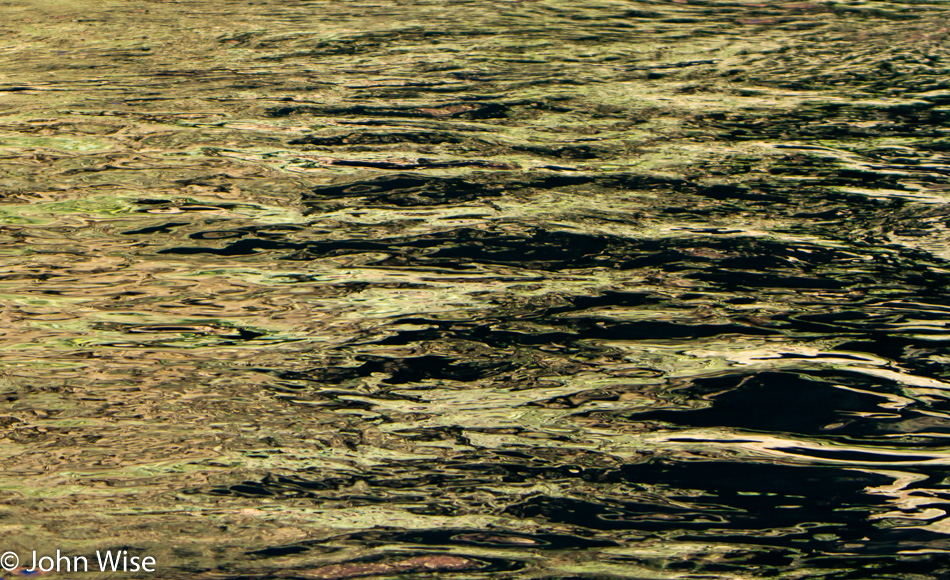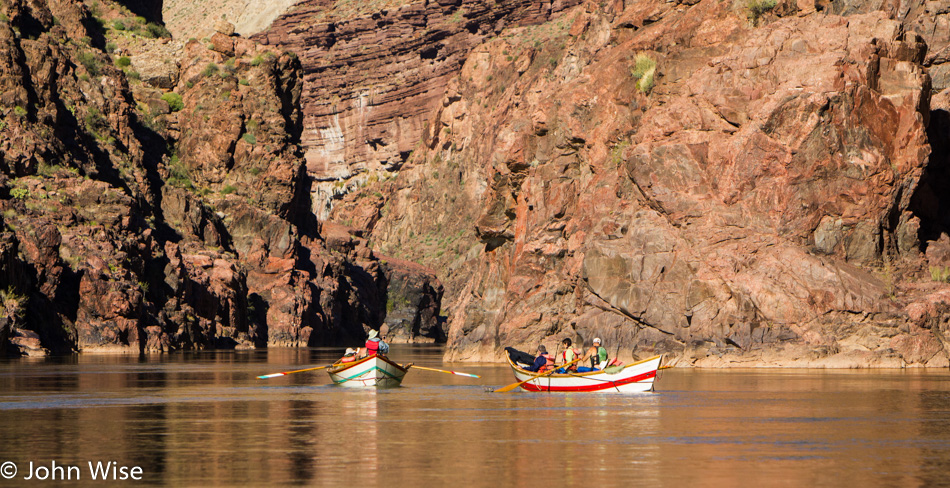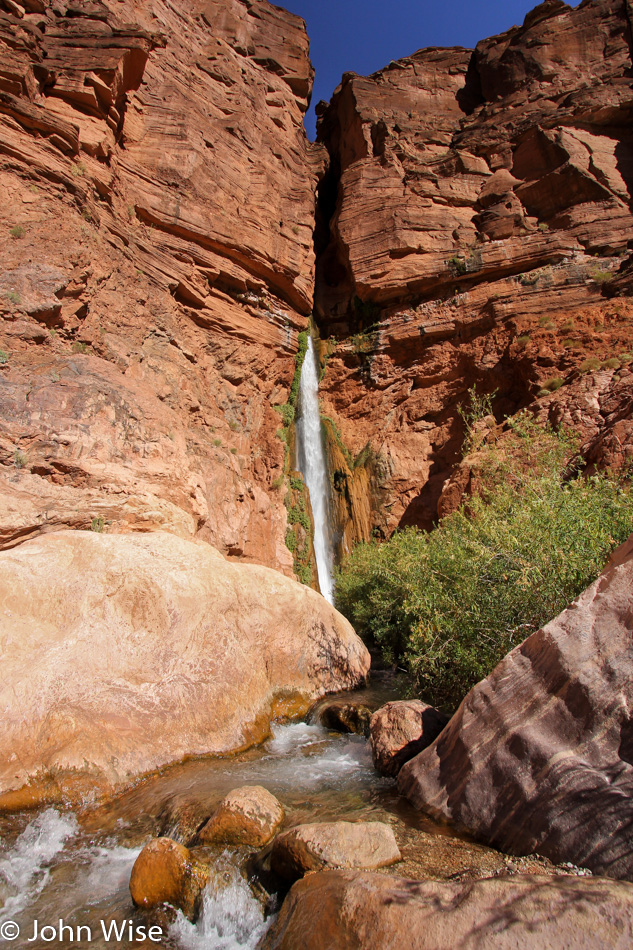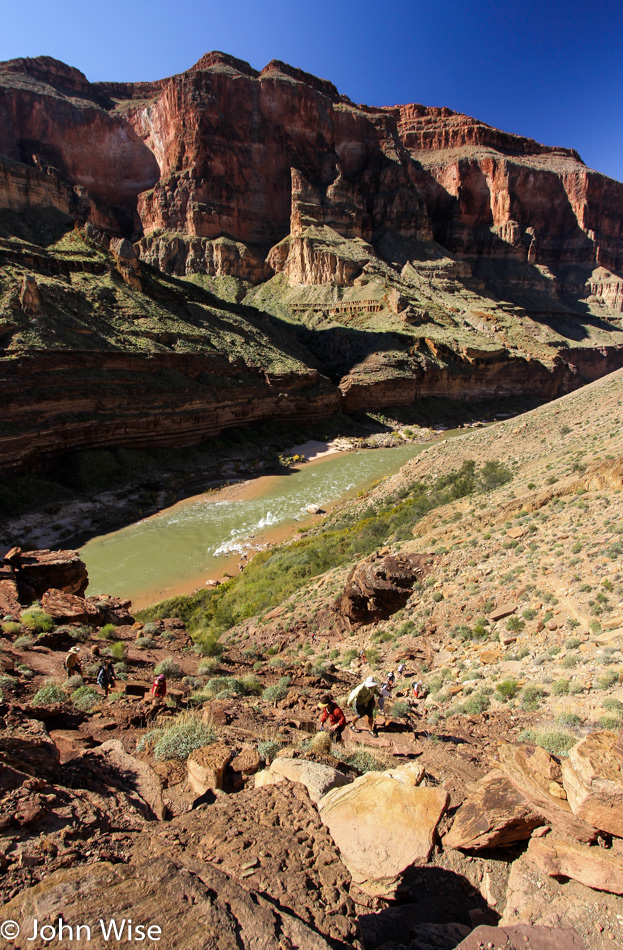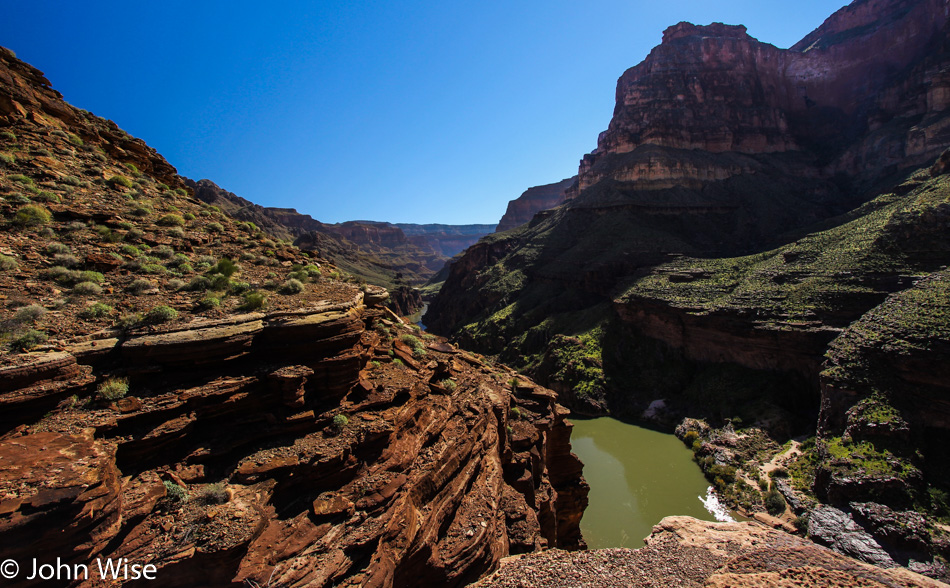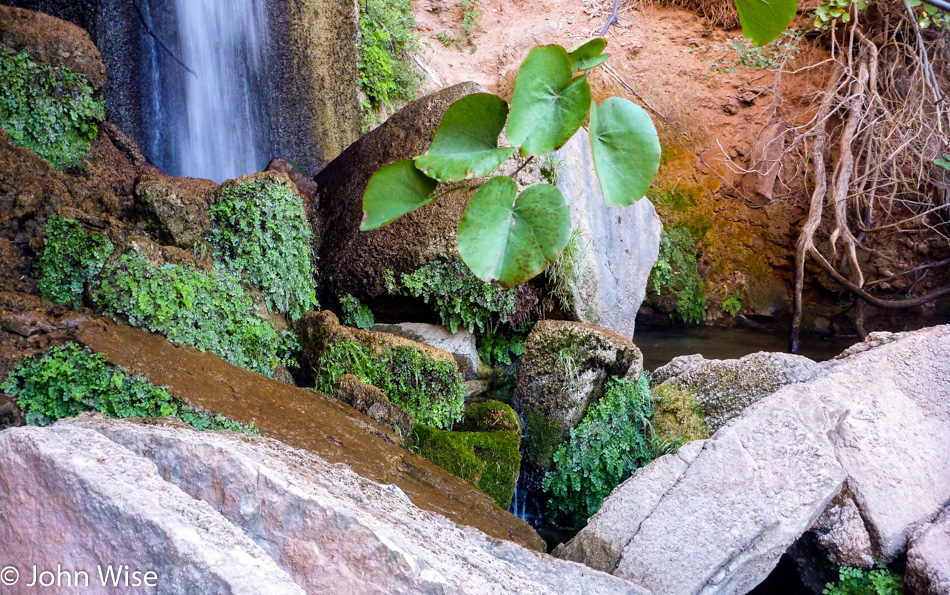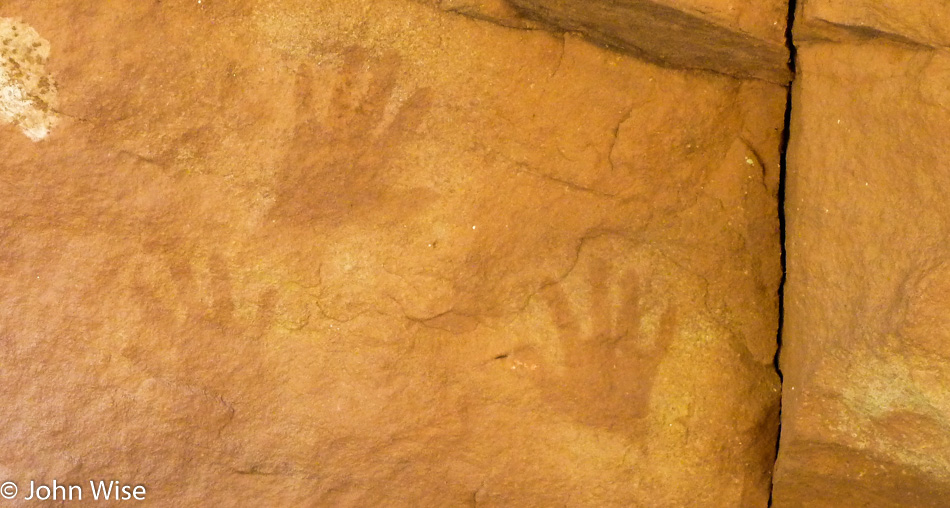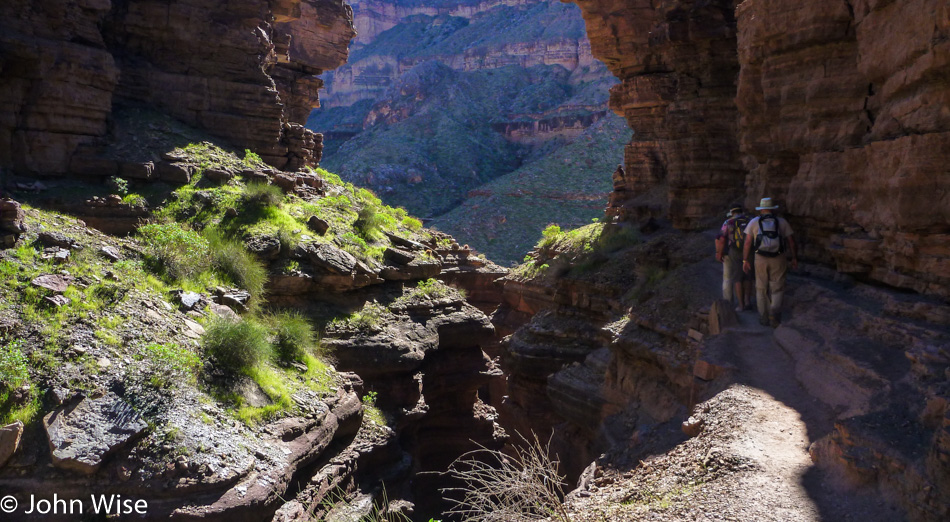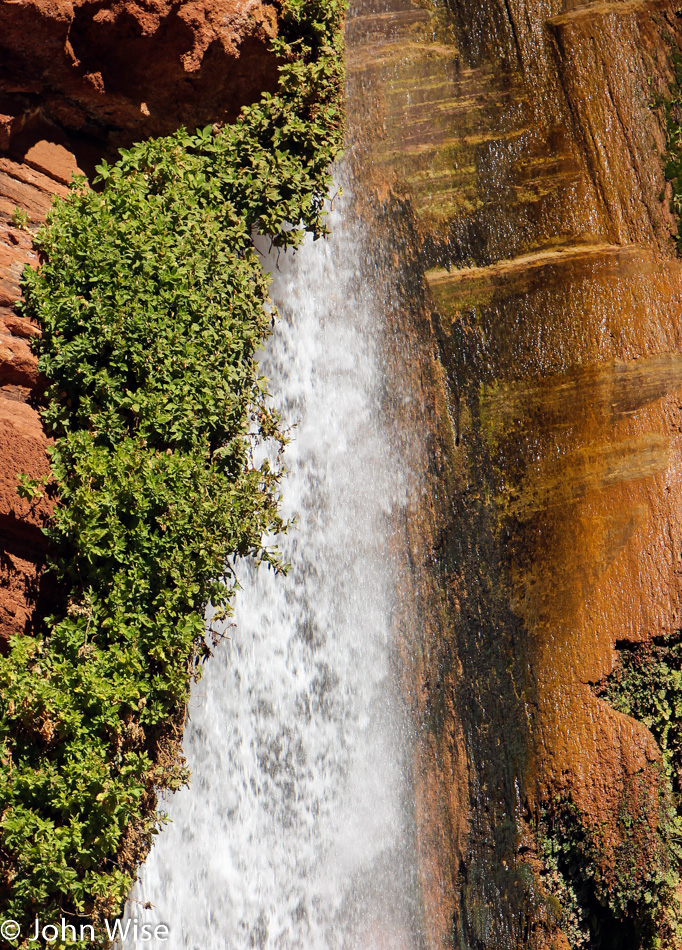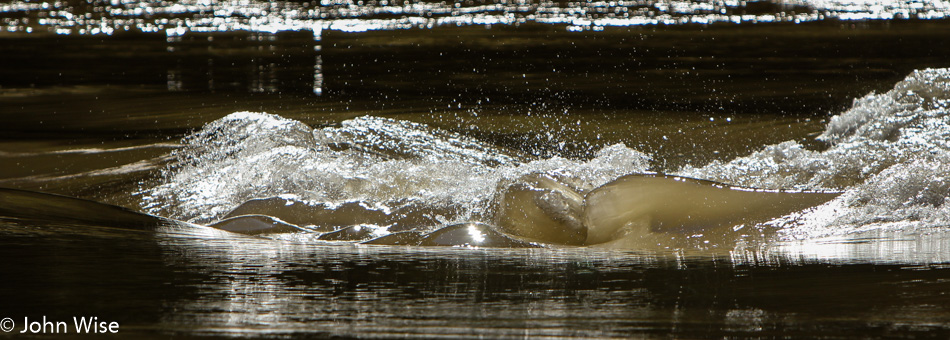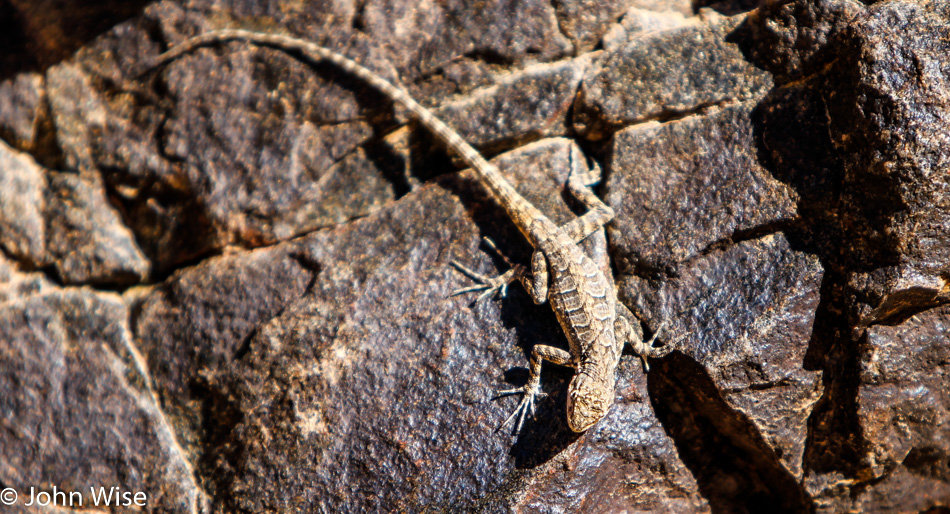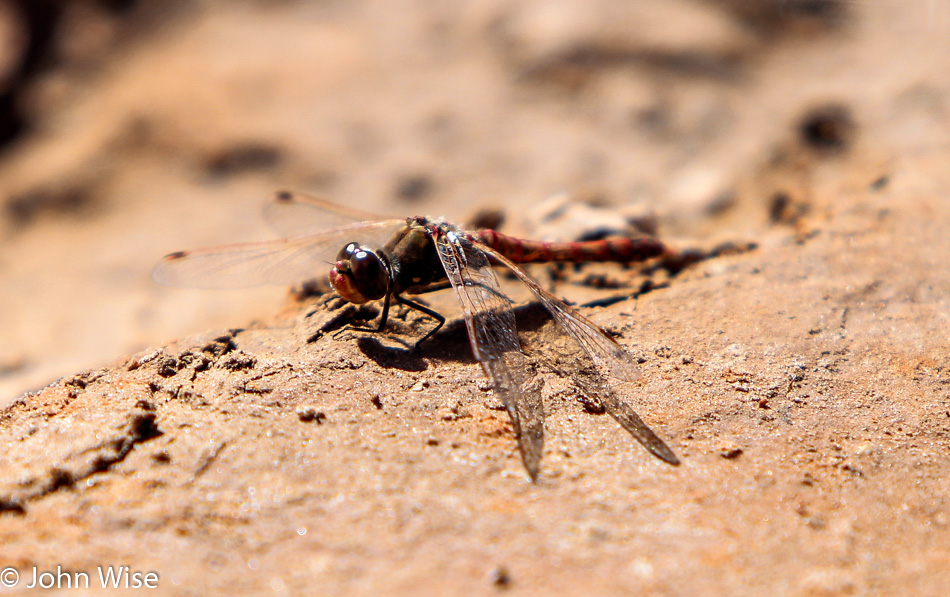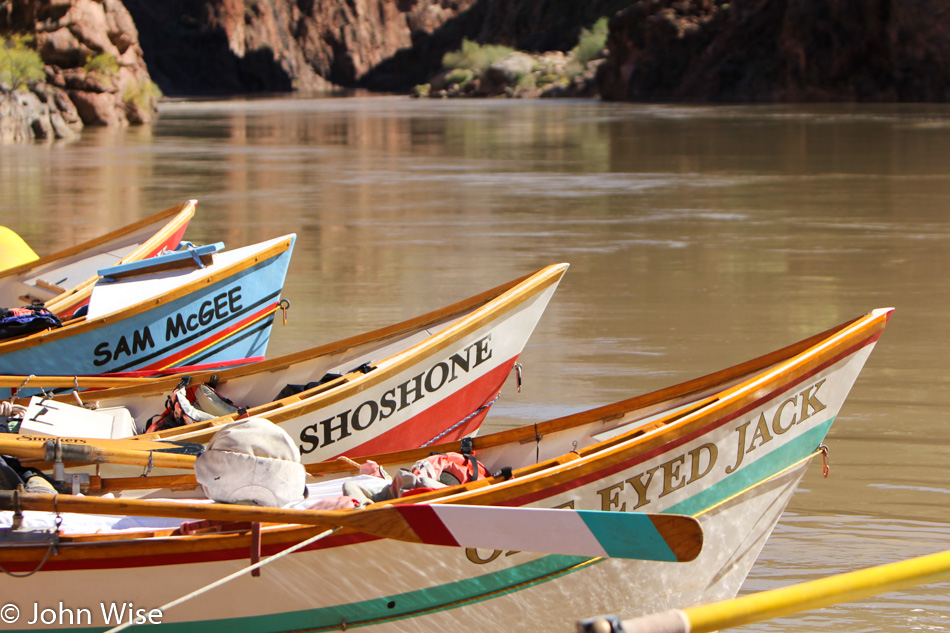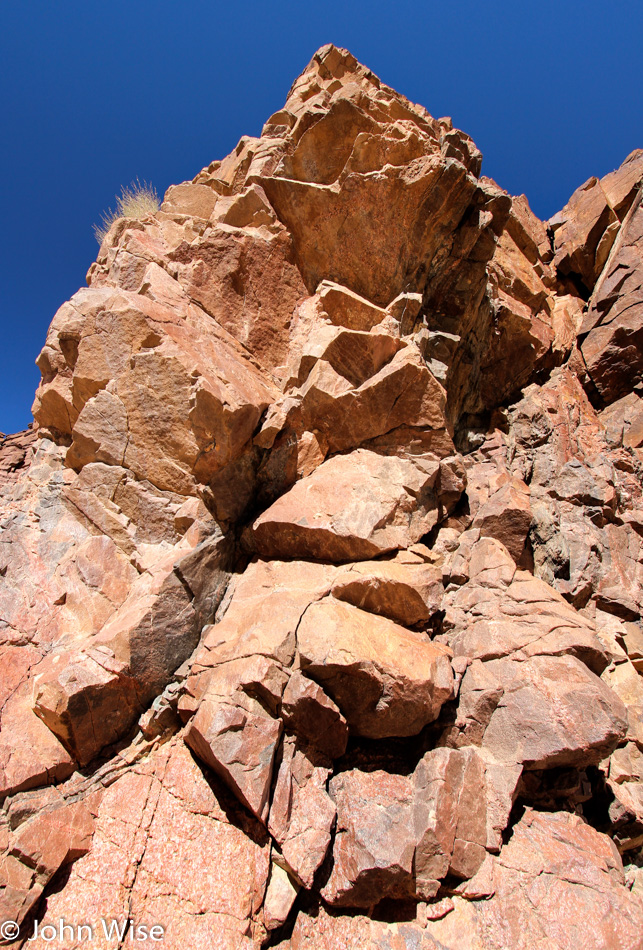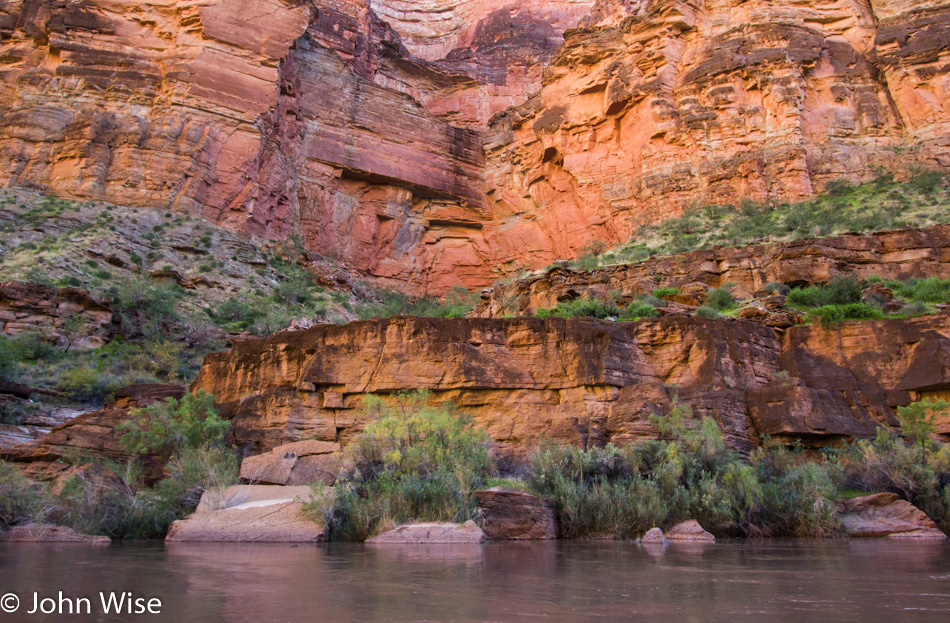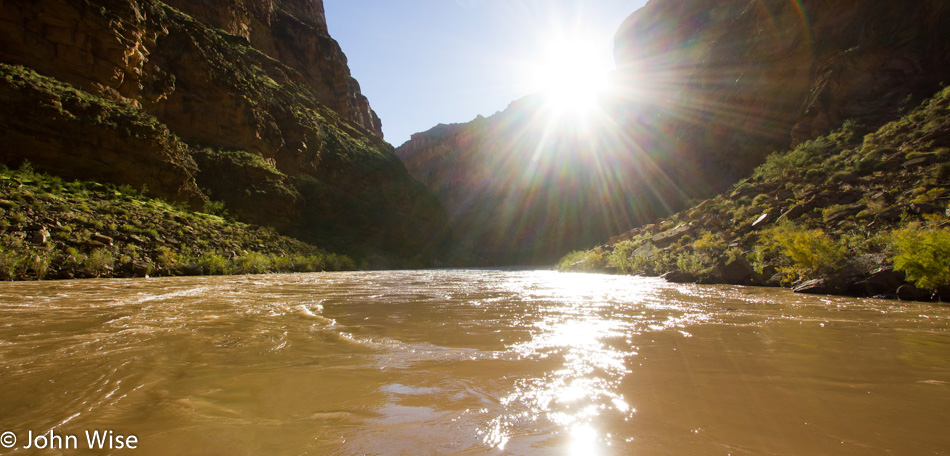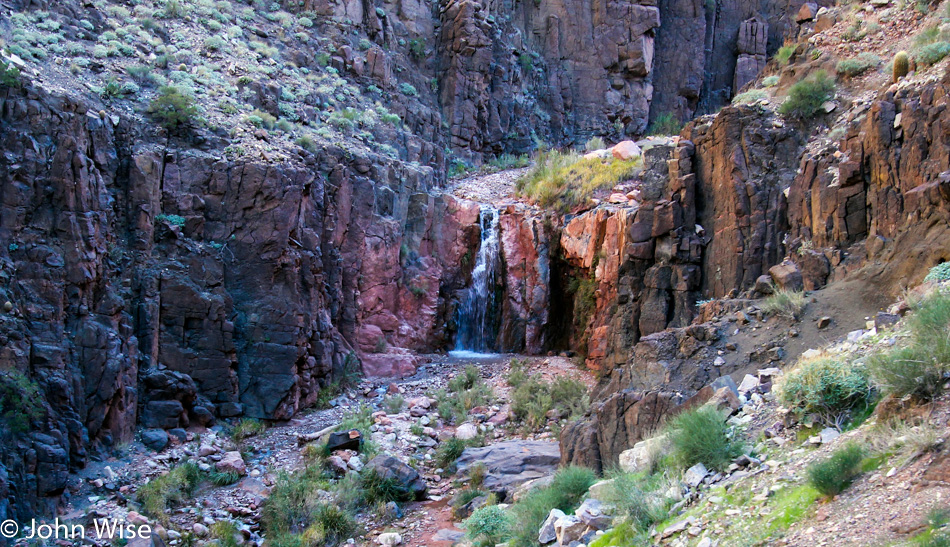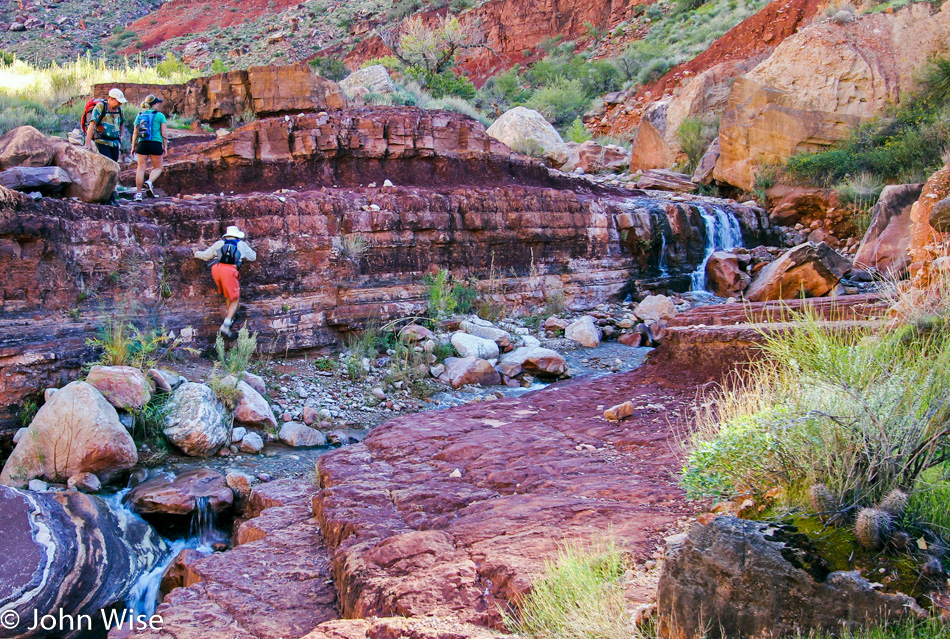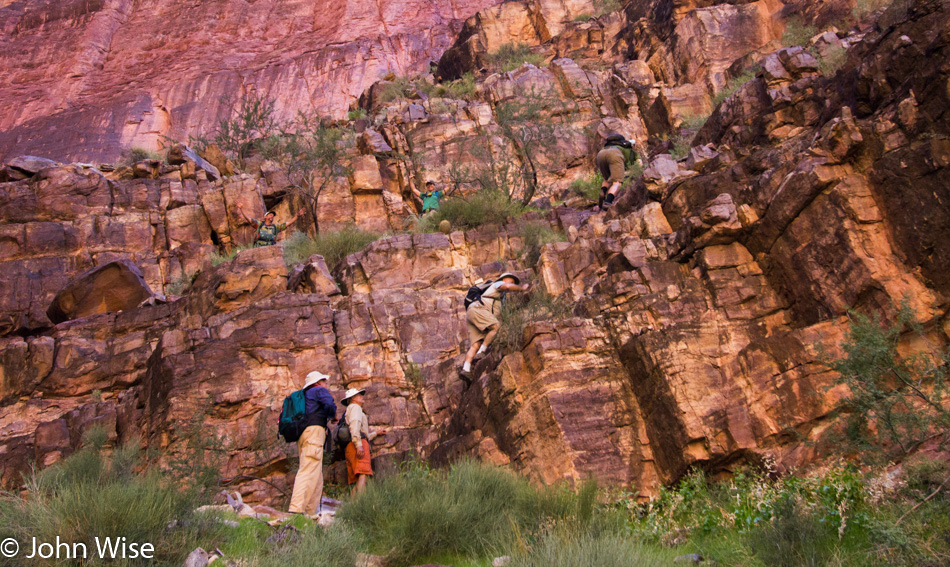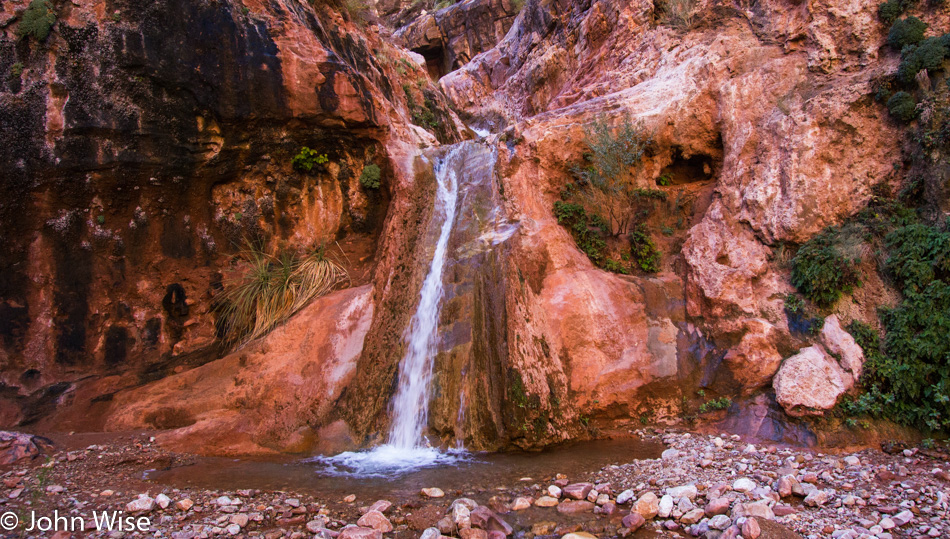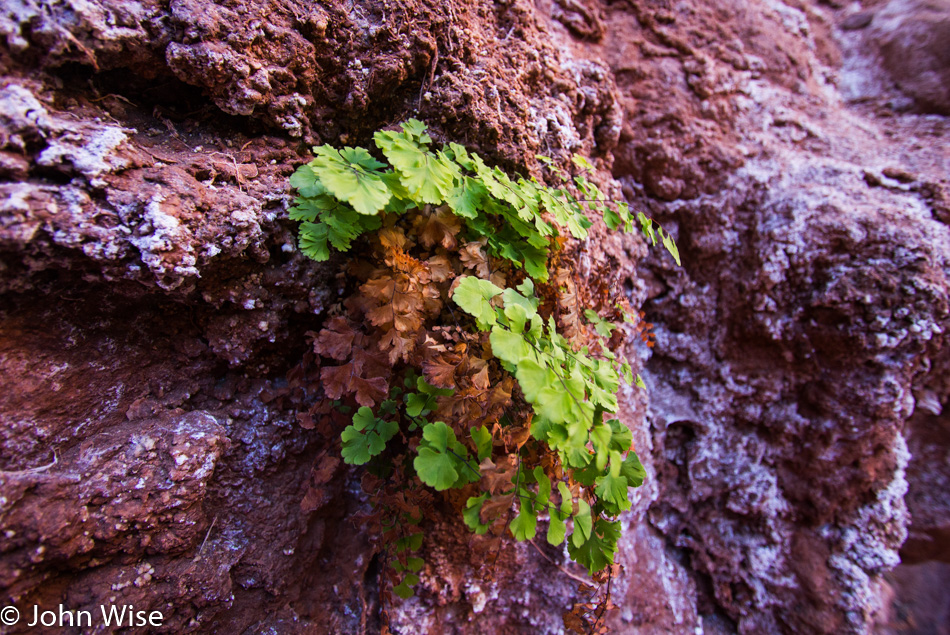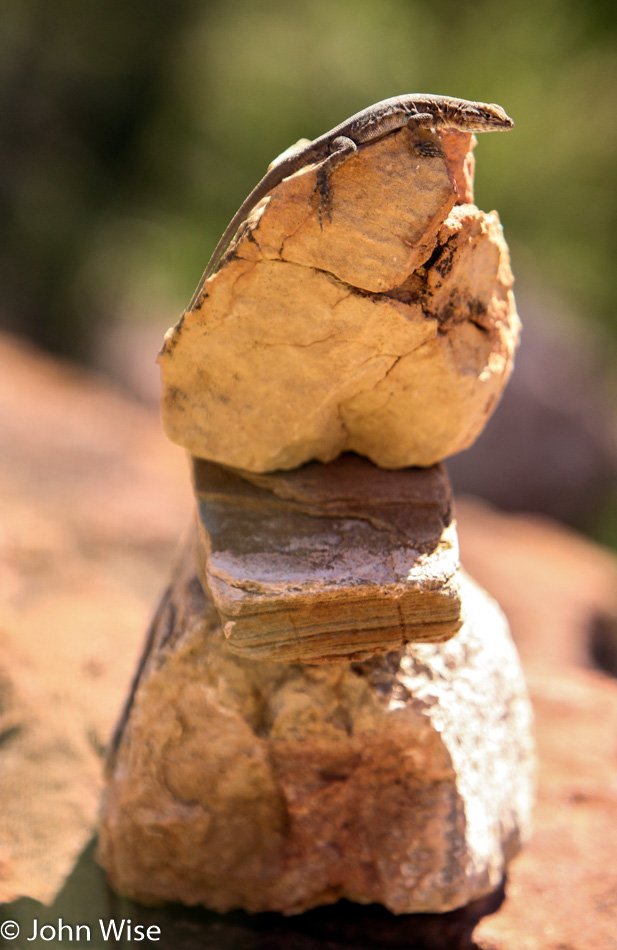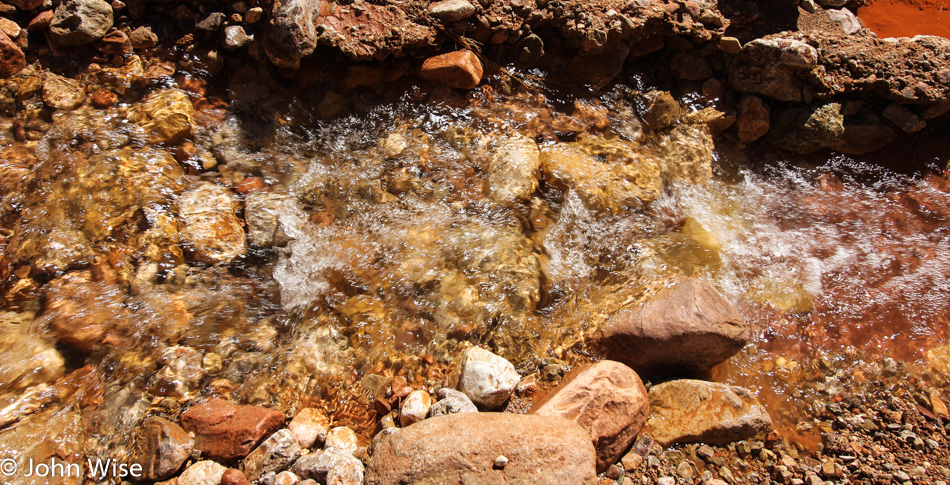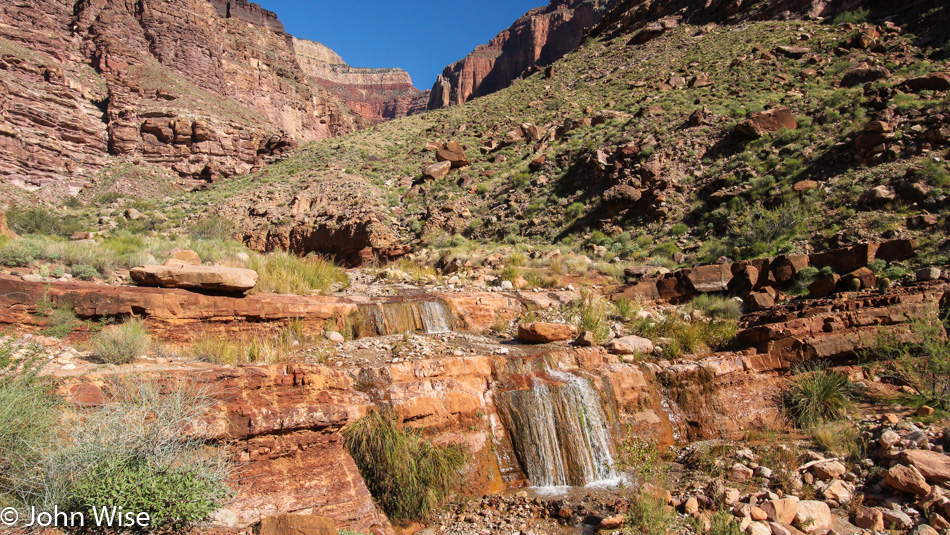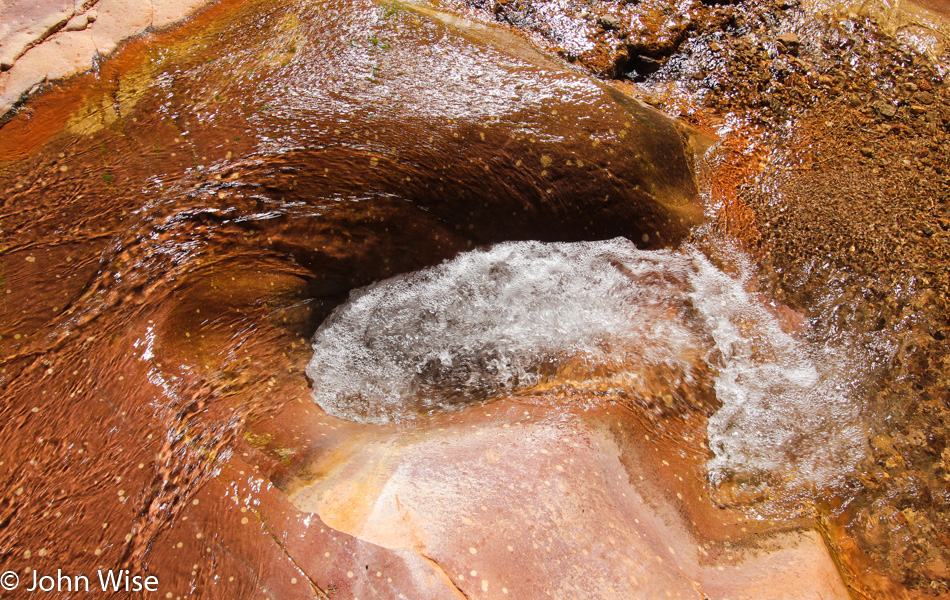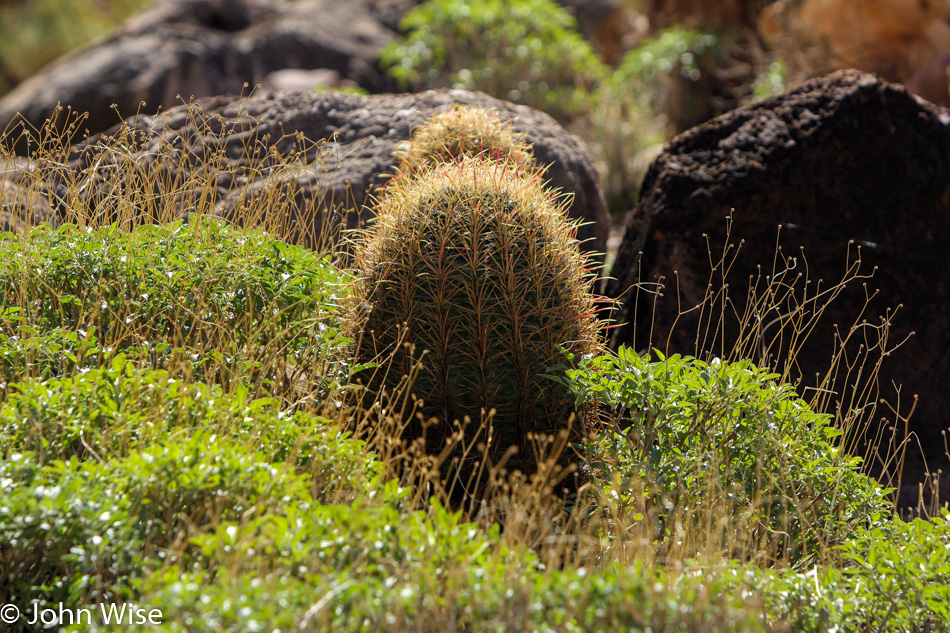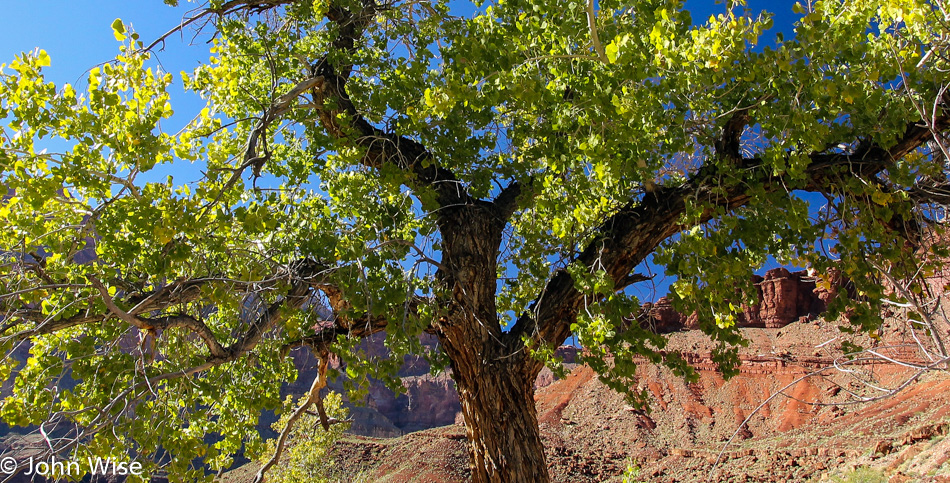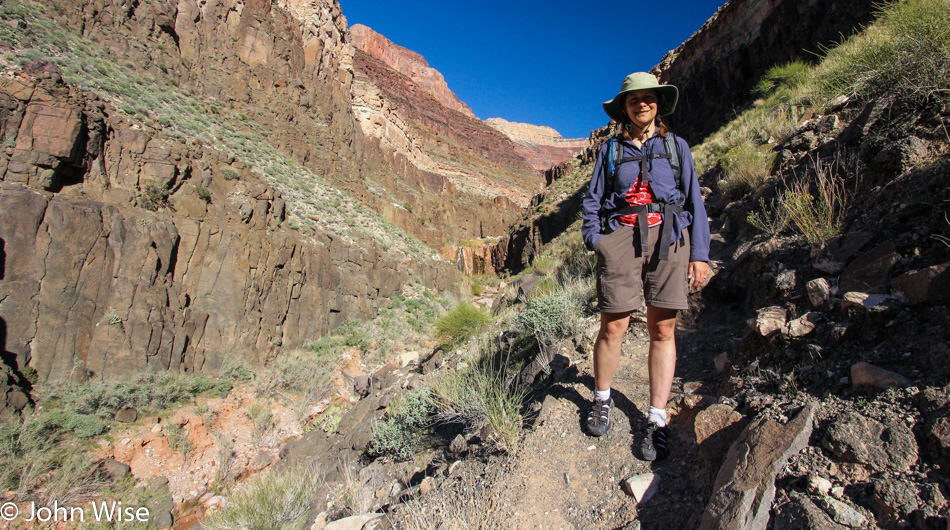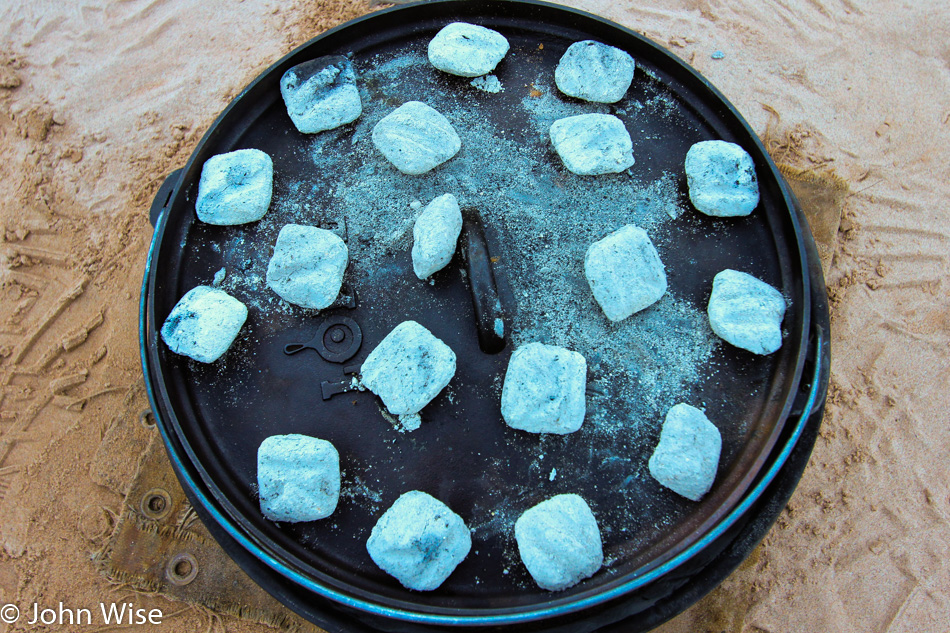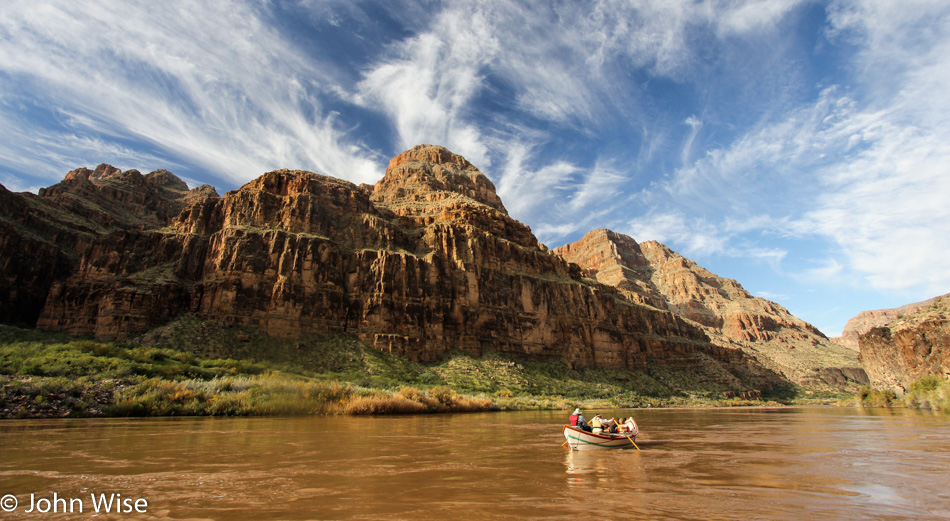
Look around here, and you may find the stupendous. After 16 days on the Colorado, buried in the bowels of this Canyon, my eyes still hunger to see deeper into this colossus of the profound. Layers upon layers rise into cliffs of stark columns. Desert varnish paints the fossilized sediments with a bronzed finish. Ancient ruins whisper mythologies onto the tapestry of history – we listen to the faint voice of their echoes. There is so much to take in. As the author Terence McKenna once said, “The further you go, the bigger it gets.” I think of the first day when we put in at Lees Ferry and have to question whether I was seeing a fraction of what was right before my eyes back then. Now, with little more than 30 miles left between me and rejoining who I once was, I can only hope that my understanding of this Canyon and my place on our Earth has forever improved.
Turn these boats around, boys; we need to drag ourselves back through those shallow constrictions and boulder-choked channels to bring me back to mile zero. We’ll resupply and restart this jaunt into my soul, now that I know something about myself in relationship to All of This. Next time, I’ll be certain to extract a full minute of impressions for every second that ticks by on the clock.
I’m surrounded by blossoming spectacles of nature. On one side of the river, sloping hillsides bathed in green crawl upward to terraces of red and tan sandstone, stained in the patina that comes with age when you are made of stone and live in the desert. On the other side of the river, the surfaces are stripped bare, just the naked sheer rock rising to menacing heights. Between the random forms and chaos of erosion, it becomes apparent why some of the buttes and mesas are called Shiva, Brahma, and Vishnu. The formations and pinnacles stand in as proxies for the temples that have inspired their names – Hindu and Mayan-looking formations too numerous to list can be imagined in this landscape. For some time, we float past these homes of the gods until the river corridor widens again. Serrated edges and dangerous angles give way to softly rolling hills that only last until the next bend in the river. We then enter the world of Chichen Itza, whose temple pyramids have been rendered right here in our desert Canyon.
Ocotillo and other cacti stand like sentinels guarding the treasures in their presence – it’s also possible they are desert lighthouses guiding us, keeping us safe from the tempest. And what of those bighorn sheep seen earlier in the trip? What were they doing standing atop the highest outcroppings, out on the edge of the tiniest sliver of sandstone? They obviously were not foraging, their front legs standing at the precipice, their necks craning over the ledge as though they, too, were looking for something extraordinary.
Just above our heads, there is another flow, another stream, a river of air current. In its path, butterflies don’t flutter about; they dart along, moving with great purpose. Maybe they are riding their own kind of rapids? Butterflies are the civil air patrol of the middle channel of the Colorado. Birds are more often seen up high running thermals, updrafts, and various other unseen currents or taking it easy over onshore. Slicing a trail between them all are the visitors who come in on the breeze from a different world, flying spiders.
These arachnids are the snowbirds of the Canyon. During the summer, they live up on the forested rims, but as cold begins its approach, the spiders give off a shot of silk before tossing themselves off their high-altitude perches. They hold fast to the thread, and, like a kite, they are airborne. They float on a haphazard random course, looking for providence to deliver them from the approaching snows of winter to the desert floor a mile below.
Sitting in our dories, crawling along at sloth speed, we see shiny glimmers and twinkles of the sun reflecting off the undulating silk lifelines the spiders are clinging to. The silks ripple in the sunlight, mimicking wisps of smoke, and then here and there, a strand falls into a shadow, magically disappearing before reemerging in the sunlight. Many a jumper misses its target on the lowlands, to become an evolutionary experiment in which nature tests the spider’s ability to swim. Others kamikaze themselves with direct hits on our craft. I wonder about the survivors who become stowaways, finding a dry corner to hitch a ride in; then, in a couple of days, they will start a cross-country drive to Flagstaff, Fredonia, Angels Camp, Grand Junction, or any number of stops between, depending on the city and state a boatman calls home.
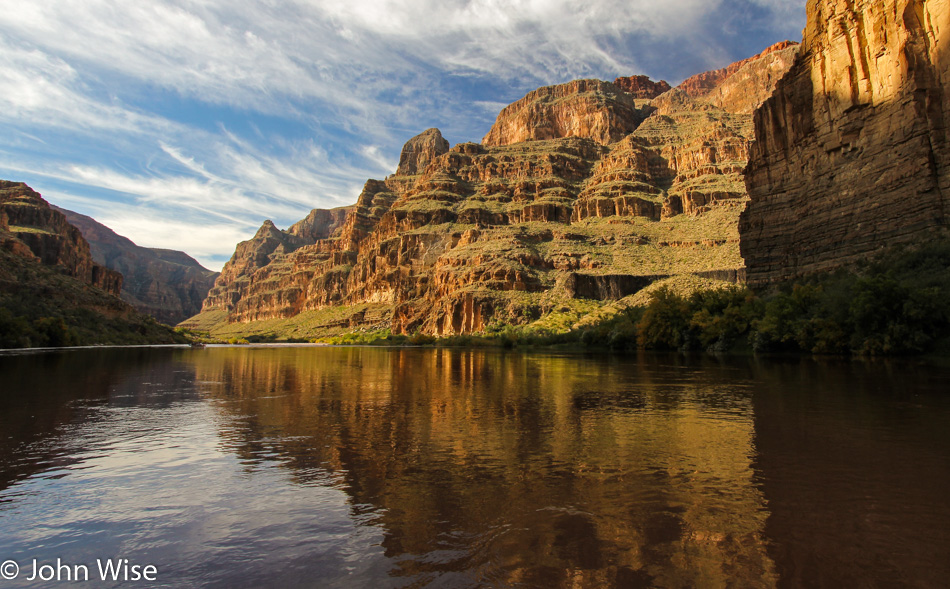
We are taken to the edge of being hypnotized. The dip of the oar, the warm pulse of the sun, and the hundreds of silver threads weaving a slow dance in the sky charm us into a trance. Capturing these fleeting moments in my camera, where the thinner-than-hair spider silks float in the streaming rays of sunlight, would never portray the enchanting play of nature these sights inspire. Do others know the beauty of our world that the senses are able to perceive? Can a man reveal the raw emotions able to be brought on by his encounter with the natural world? Or does he only have some vague idea that something is different? We must learn to swoon in our exploration of the rare; we must let go and let the heart forget what trouble it may have known. We should strive for awareness in these beautiful moments. It’s all love when we are in the wonderful.
I want to extend the view and find treasures never before witnessed. Ones that would allow me to continue my narrative for another 100 pages. I need to enlarge the rabbit hole, tunnel ever deeper, to keep myself falling forever. If I run out of river, will I run out of words? Can separation anxiety be portrayed as a part of my experience without it being a downer? Months ago, when friends had been curious how we would deal with 18 consecutive days of cold and wet primitive conditions, I had remained strong in my resolve and told them it would be easy. Then, a week before we left, I began to question my resolve and fell into doubt that we had fully understood what we bargained for. Now, I’m faced with explaining to my friends how difficult it will be to be amongst them once again. I’ll try to tell them how 18 days in the Canyon were not enough. During the days that became weeks and then months that followed, I sequestered myself in the remembrances of these 18 precious days, requiring another couple of hundred days trying to relate a fraction of what I saw and felt.
This journey should have been sold as the adventure you never leave and that never leaves you. Life-changing, monumentally epic escapes, which take us inside ourselves, happen in terms that may as well be in a foreign language we neither speak nor understand. Perhaps a few of our friends and family members who have experienced similar epiphanies will be able to return the sparkle in our eye or be able to share the knowing smile we offer, which gives a hint at the enormity of growth we encountered. I feel that while I have been awakened, much of humanity will be left simply trying to survive or worrying about the drudgery of routine instead of making time to dream of tomorrow’s adventures.
Yet here I am, trying to extend the cascade of epiphanies, to enlarge my vision and the carrying capacity of my memories. Too many miles have already been rowed today; only 23 miles remain. I have no choice but to start my departure, though my heart may never be ready to leave this experience. While writing these words, I can also see their end, bringing me to the point at which I have to face leaving a second time. There must be some play of color, a contrast of elements, or a layer of earth not yet written of that can be examined in detail, opening a new chapter for my imagination to traipse through and convey on these pages.
Instead, we float. The boatman row. The miles collect. And we close the distance between here and another world – our old world back home. Caroline is out front enjoying her last bow ride on the Lost Creek, rowed by Kenney. The ride wasn’t so much on a rapid as it was on a slightly bigger riffle, but that didn’t diminish any of the delight Caroline took from the most exquisite seat on the dory. At mile 205 a rapid approaches, the last of the “Big Ones.” Good grief, the finality of it all. Mile 209 finds us at Granite Park Camp, and it’s only noon. An early day to allow us the chance to relax and take it easy – which I don’t want to do; I could do that at home on some weekend.
Granite Park is a wide expanse of beach and desert. Sparse plant life sprouts from the living cryptobiotic soil, teeming with microscopic cyanobacteria, lichens, and fungi. A hike is on offer that will take us through this fragile landscape and deeper into the Tapeats layer. As an added bonus, we will be seeing a recently discovered arch named after one of our boatmen. We will be leaving shortly after setting up camp.
Much of the landscape we have traveled through these days has shared the same palette of hues, splashed with flourishes of the entire spectrum of earth tones as though they were painted with the end of the rainbow. And yet, while much of the scenery is likely quite similar to other areas along the river, to me, with senses overloaded, the view is as unique and possibly even improved upon when compared to what I saw minutes or hours before. Motifs surrender their hidden forms from out of the shadows, demonstrating how patterns taken from Earth’s design have influenced the imprint on life. Like looking at the clouds above us to find figures of things familiar, here, too, we can spy the outlines of various creatures and plants in the rock forms. My descriptions of these colors, configurations, and impressions of this living canvas have been hard fought for. My words tell little of the diversity of contrasting nuances that are displayed in dynamic bands, layers, swirls, and punctuations from even this one small corner of nature’s vast inventory. Granite Park is yet another iteration of those qualities that reduce the vocabulary to “Wow!”
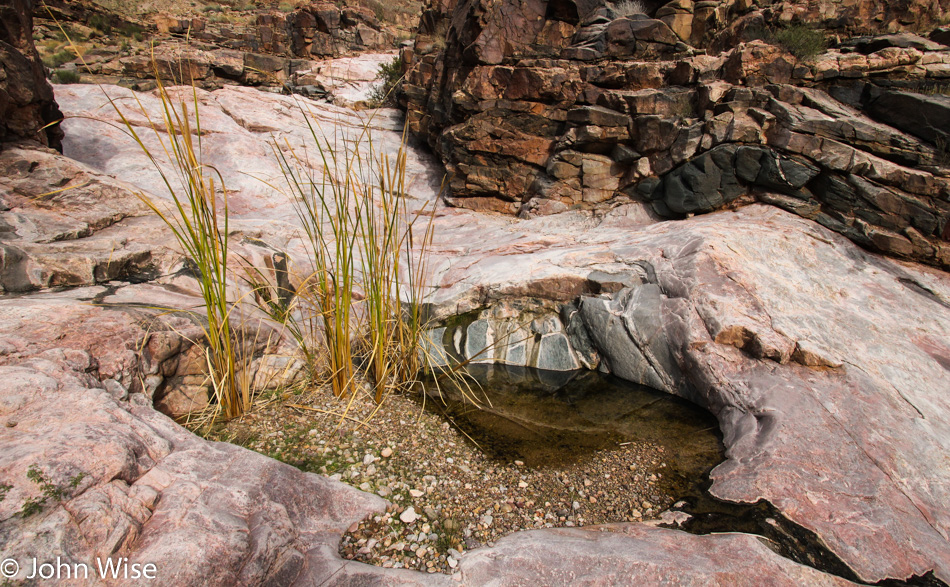
“Glorious,” “vast,” “deep,” and “profound” are often among the words used to convey a sense of admiration for this National Park. One could read every line ever penned that has attempted to illustrate the immeasurable Grand Canyon, and still, upon entering this serpentine maze of the sublime, one would know little about what was about to greet their naïveté. Hop aboard, but be prepared, for as you move forward, the world is unfolding. Step ashore and watch as the trail takes you further than your imagination ever dreamt.
With our tents pitched, we are about to walk into another one of these extraordinary visions. We start our hike from the river’s edge. A grizzled and stubborn old tree said to have been here during Powell’s visit has seen firsthand what power the river carries. And while it has a hunched back and obviously looks the worse for wear, this old Goodding’s willow has managed a mighty long visit, judging from the struggle it has made to remain planted here.
Not far up the trail, we come to a panoramic overview of the river, beach, bushes, and towering cliffs in the background – our home for today. Continuing just a short distance, we are soon in the main drainage of the side canyon. It is mostly stripped clean of plants as rock, tree limbs, and debris, carried by the rush of periodic floodwaters, has scoured the channel, leaving behind a rock garden decorated with boulders and stones from further up the canyon. Ahead of us, we begin to see possible paths we might choose to follow. Some routes run into sheer walls that cancel hiking in that direction. A narrow path with a steep climb looks like a potential continuation of our exploration. From our new view, the cliffs that had appeared to be in the distant background have suddenly grown in stature; they are much more formidable now than just 10 minutes ago.
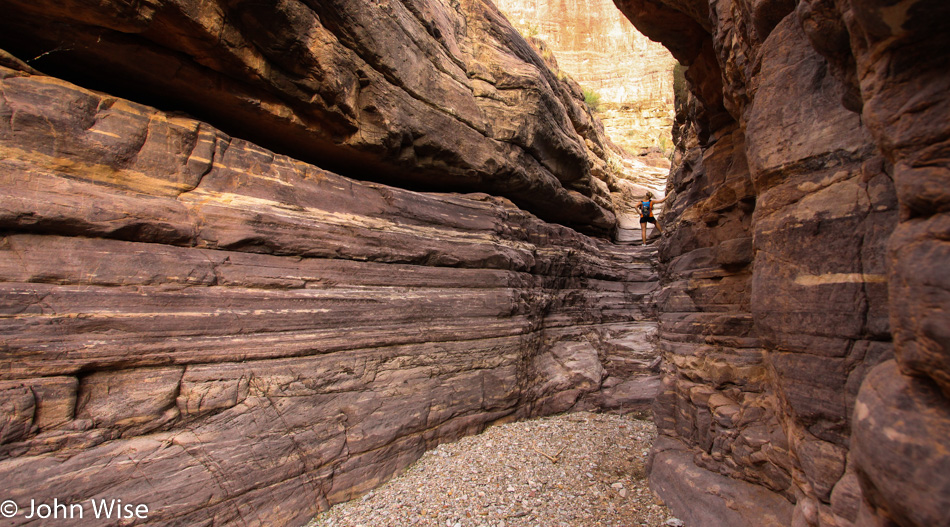
Climbing over ledges and around boulders, we enter the hidden world of a small slot canyon. Two days ago, I had understood that National Canyon was our last slot canyon, but stand corrected. National was to be the last of the “big slot canyons,” this is a mere small one. But small does not diminish its grandeur. The intimacy of finding myself in the narrows of a place where I can at once comprehend its scope and have it act as a kind of blinders to the greater canyon it is buried in leaves me feeling protected. While hiking a slot, there is a sense of being cocooned, of being hidden in a cozy little hideaway, alone and in silence. Like in a cave, yet with the benefit of natural light. I can look around and see it all, move in closer to examine the details of this stone womb, which is not easily done when opposing canyon walls are miles away. Although tranquility can sometimes be deceptive, when the rains come to purge this channel it would be the last place one would want to be caught hanging out admiring the finery.
The trail zigzags as it gains in elevation. Small depressions in the slick rock act like water pockets, one of them feeding a small family of cattails. These plants are powerful reminders of the ancient seas, lakes, and wetlands that no longer exist here, as the environment continues the process of being converted to desert. They are now in their state of winter dormancy, biding their time until spring when warmer days will trigger a signal in the head of the cattail to open with a puff of fluffy wisps that will float off on the wind. Their seeds will fill the sky, looking to find another elusive pool of nourishing water on the way to establishing yet one more foothold before the desert fully takes over.
We reached the vertical rock, but I left my hooves on the dory. To demonstrate where to place our feet, a boatman in flip flops leads the way, and the rest of us follow on a trail that didn’t exist before the imagination of our guides willed it into existence. The thought crosses my mind that we’ll likely be returning this way – but this is not the time to worry about the impossible. We follow in his footsteps and, to my surprise, find ourselves able to leap vertical walls in a single bound or two.
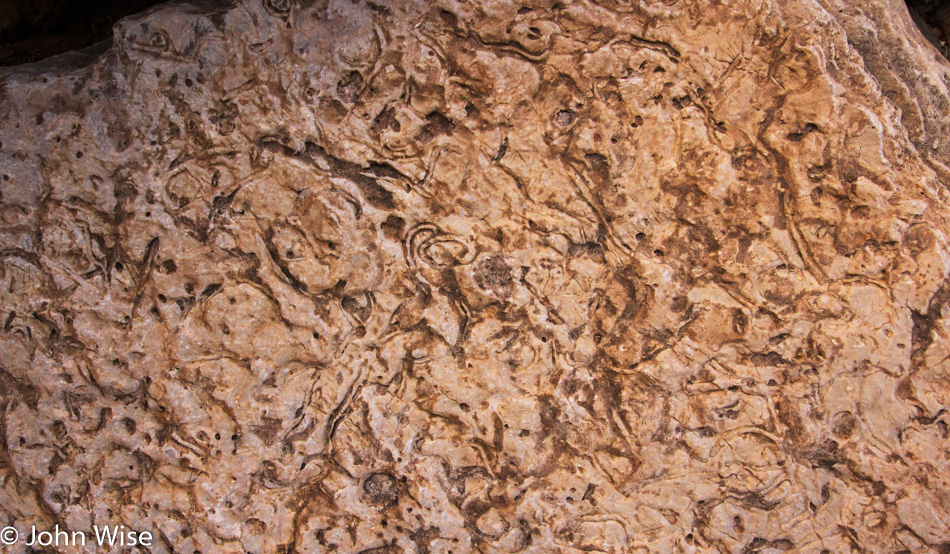
Are those worm fossils? That was the first thought in my head as my eyes tried to decipher what the fossilized tubes might be. Close enough, they are channels in which worms once lived so many millions of years ago. What other remnants of lives past lie just before us that we don’t know how to see, whose shape doesn’t offer a familiar form to give immediate recognition to? Note to self: upon getting home, find the outfitter who brings a geologist, an anthropologist, and a paleontologist to guide us on a return journey of exploring the fossil and historic record of the Grand Canyon, and don’t forget the musicians.
Is that a dead millipede? Sure enough, it is a six-inch-long, desiccated specimen, half curled up in the gravel, and it’s not the only one. Not knowing the first thing about the life cycle of the ‘pede’ species, I wouldn’t be able to explain the autumn die-off that occurred in this canyon. The mystery of the millipede lives on while its life has come to an end.
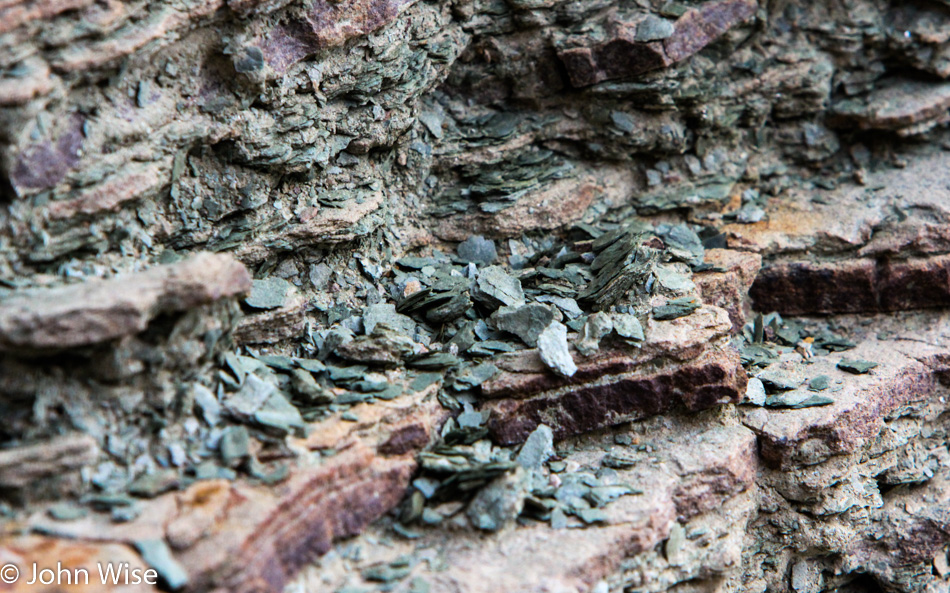
Basic knowledge of the vast potential of nature seems illusory to my mind. What would basic knowledge consist of when the complexity of existence spans physics, chemistry, biology, ecology, climatology, hydrology, geology, and many other -ologies? How can I hope to have an adequate foundation of information that would allow for a full comprehension of this environment that has recorded the evolution of life? How does the average person gather the knowledge to understand such a magnitude of detail?
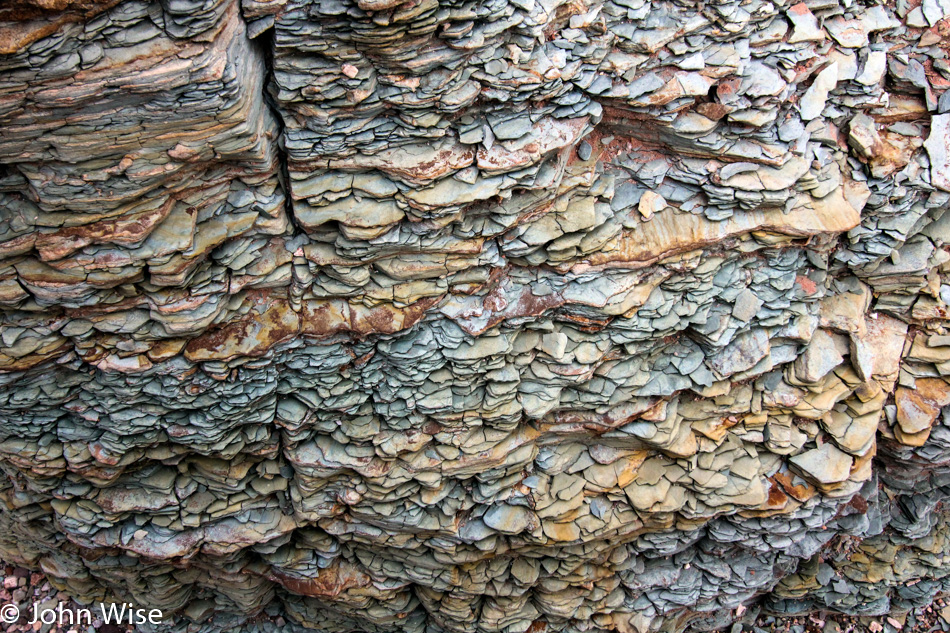
Our trail crosses a myriad of layers: solid sandstone, gravel beds, sand, and off to our side on the Canyon wall, shale. Greenish-gray chips of fractured shale fall from the wall, spilling into our path. The pieces we walk on crunch and break underfoot. Over time, they will again turn to dust and be blown to the four corners. Some of these new sand particles we just kicked up will find their way to the river before settling into Lake Mead, further downstream. At some point in the distant future, maybe Hoover Dam will no longer stand where it is today. Maybe, if we are lucky, none of the dams on the Colorado will continue to impound this river, and the sediments can continue their voyage to the sea.
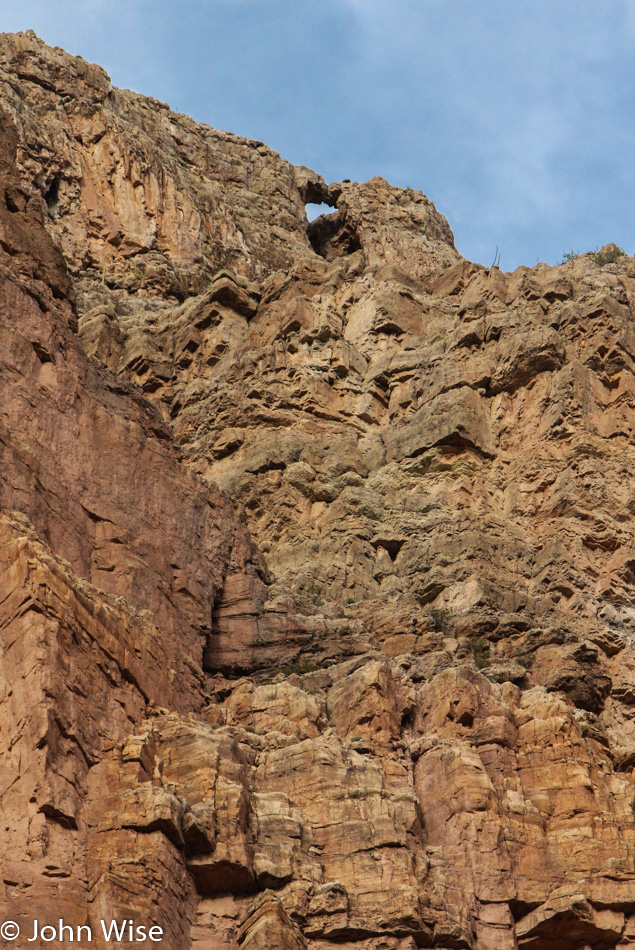
Out of the drainage, our view opens up to the broad expanse that now spreads out around us. We turn left and continue our hike, heading towards the canyon wall further up until, near the sheer cliff wall, if we look up at just the right spot, not too soon and not past a certain stone, we can see Ashley Arch in the distance. This is not an official name but is the name we use on this trip, as the boatmen haven’t been able to identify this weather-worn feature in the literature of what is already known to be down here. It is our very own boatman and guide, Ashley Brown, who spotted the arch on a previous hike, and who has lent her name for its unofficial designation. For the next ten minutes, we mill about. Some small talk is going on between the boatmen and the other passengers, but I’m busy scouring the area for the minute details that stand in the shadow of the arch towering far overhead.
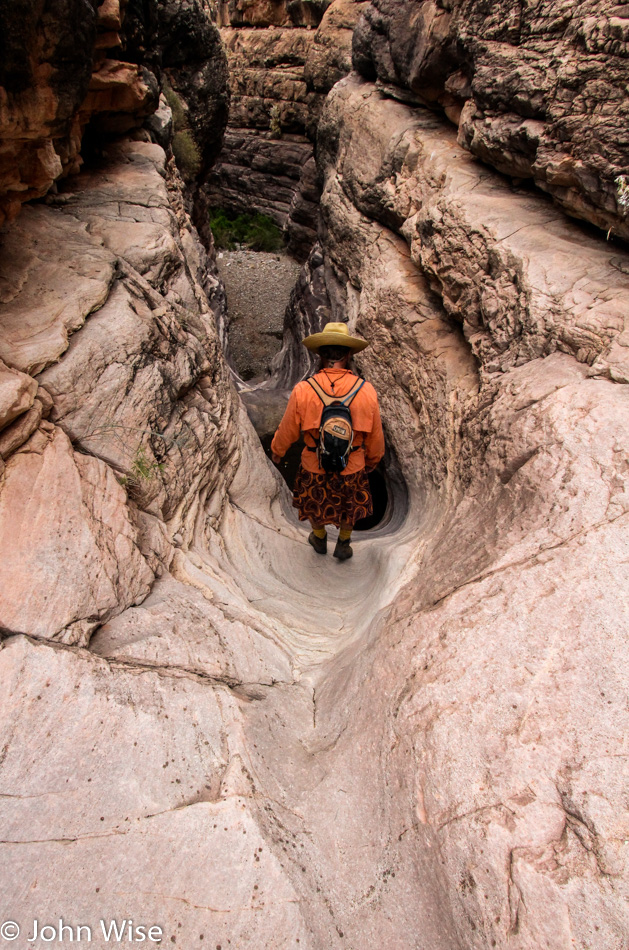
Caroline suggests we start moving down the canyon before the rest of the group so we can stay ahead of the charge back to camp and enjoy a few minutes moseying at our own pace. As we go, we take time to reexamine the sights we had passed on the way in and eyeball what was missed. It begins to dawn on me that this must be a whole new Grand Canyon because it sure isn’t the one I was in yesterday. These rocks are not like others found on previous days in the “other” Grand Canyons. This erosion is not exactly like the patterns I saw back in Saddle Canyon, although there is some similarity. There are cacti here, too, but more of them, as though this were a different ecosystem. The different layering must surely confirm we are in a Grand Canyon unique to river mile 209. Not only have we walked through yet another iteration of the Grand Canyon, but we are also walking through a thousand lifetimes of the amazing.
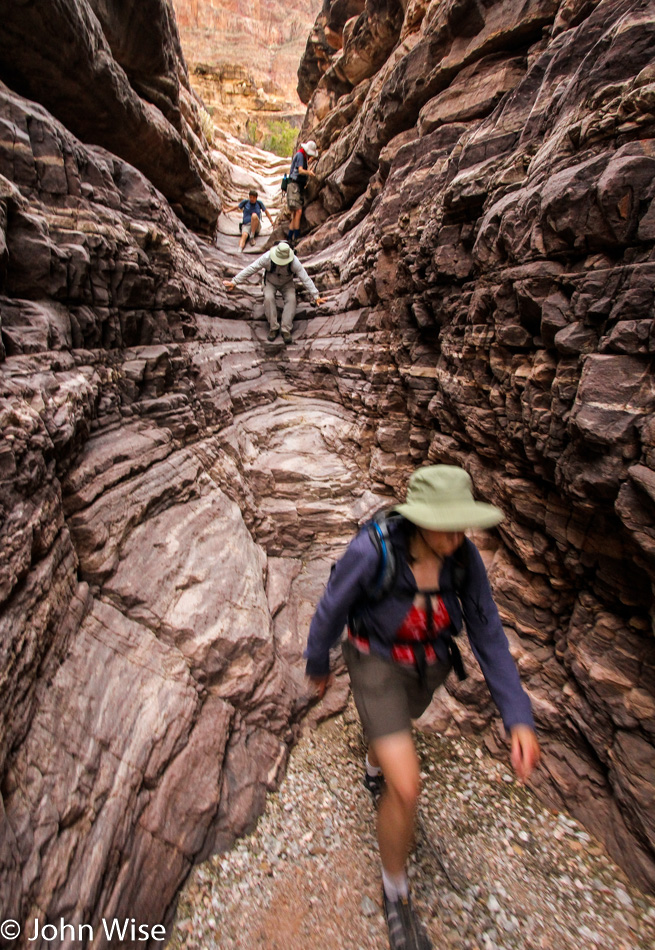
Entering the Grand Canyon, I had hoped to understand not just a little of something but that I would grow to have become familiar with a lot of everything. While I have grown to appreciate the complexity, diversity, and overwhelming abundance, I feel that I have only peeled open the first layer of the onion, which has given nourishment to feeding a larger curiosity about life itself.
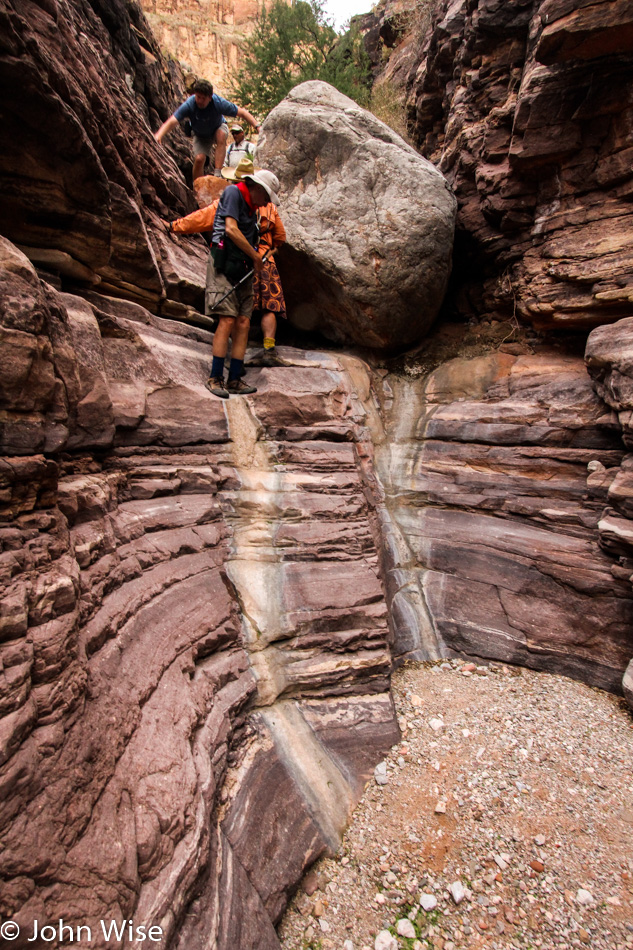
Maybe our group was developing a greater curiosity about where the two of us went because here they came. Just in time, too, as the trail is entering the narrows where, a sure-footed example of where to place our next step would certainly be appreciated. This is not the place to take unnecessary, potentially dangerous risks beyond what we already agreed to by putting ourselves in wooden boats to ply the whitewater of the Colorado. A broken bone of any sort and the flying ambulance is summoned to pluck us out of paradise, to be whisked, dirty underwear and all, to the fluorescent-lit, polished vinyl floors of a sterile clinic, where the crash with reality would probably be more painful than the broken limb.
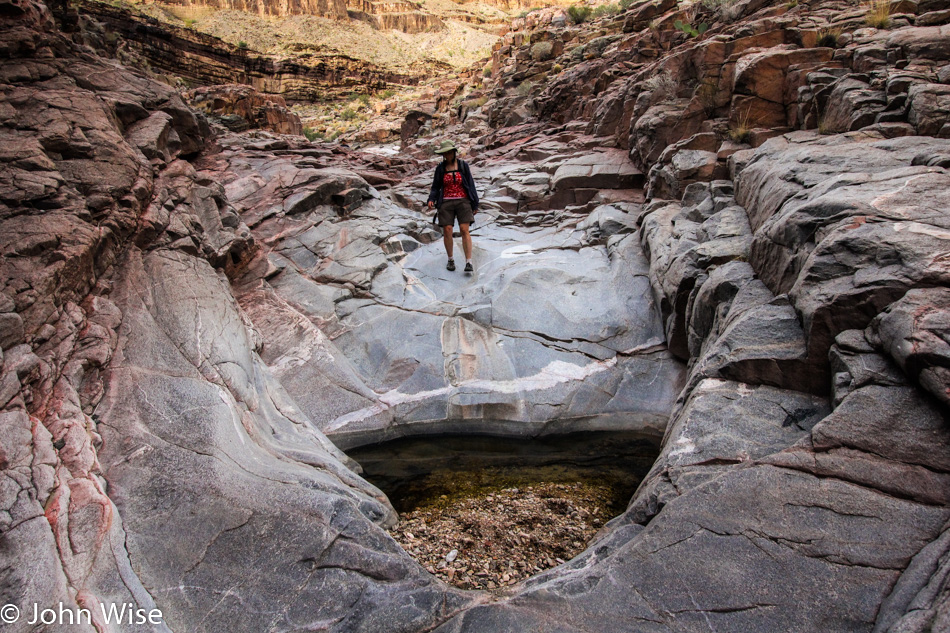
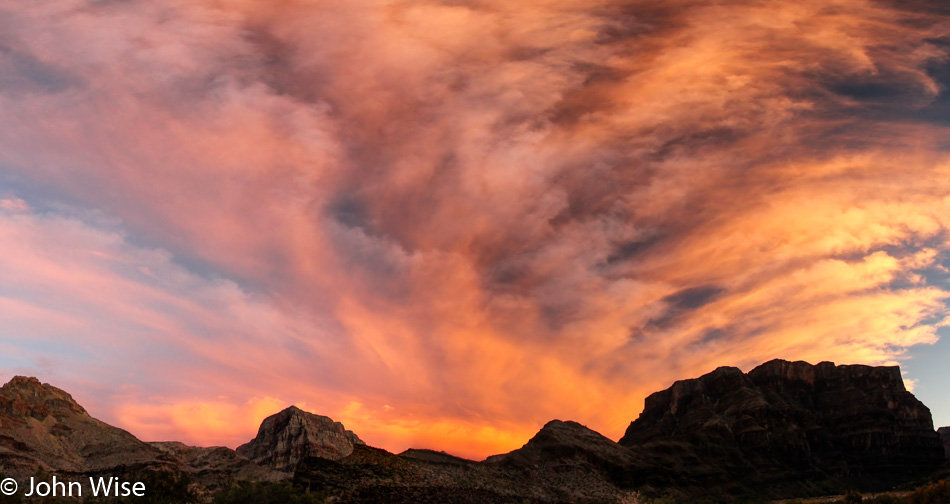
Here we are again, witnessing the perfect timing boatmen are able to manifest in the sequencing of events. As we are reentering the wide open, flat desert we call camp. Clouds as massive as the Canyon itself have become sponges for the setting sun. Flames stop short of leaping from the fiery sky. This is hardly a sunset; it is the glorious stage performance of a jealous heaven, having played second fiddle to the earth below, that has garnered our undivided attention for too long. Time to stop and enjoy the play, to stand in awe that not only is this Canyon full of wonder, but the sky, too, contains a magic that is capable of taking our breath away.
Dinner. This word is wholly inadequate to describe what we enjoy this night. Dinner is what is eaten as the last meal of a routine day. Tonight’s indulgence can easily be called a miracle. Filet mignon last night was yummy, a real treat for sure, no complaints there, but what do you call this fresh homemade baked lasagna? Don’t go getting the idea that I am ecstatic about a frozen Italian treat that was pulled out of an ice chest and tossed into the fire. This is the real thing, made fresh using ricotta, mozzarella, and dried noodles – from out of the secret food store – topped off with fresh tomato and fresh basil. The vegetarian option? Of course, it is here, too. Fresh squash, zucchini, and onions form the foundation of this lasagna, and like the meatatarian version, it is layered into a Dutch oven and baked for our dining pleasure while we are “roughing it” in the Canyon.
Compliments must be paid to Ashley for this mouthwatering delight. While she and Rondo were our cooks tonight, it was Ashley who put down the oars and donned the chef’s apron to give us what seemed to be everyone’s favorite meal of the trip. My taste buds are eternally indebted. Ashley whipped up the culinary equivalent of the magnificent arch now unofficially named after her. The beautiful sunset that parked over our camp must have been a reflection of all the warmth and care she demonstrated in doing her part to ensure our fun and comfort – on that account, Katrina, Andrea, Linda, and Frank must also be included as beneficiaries of my gratitude.
A great meal in the Canyon would rank a notch below that description without the accompaniment of great stories or music, and tonight, we have both. Jeffe has another command performance up his sleeve for us, with a reading from Robert Service. He bows his head; when he comes back up, Jeffe is a gruff frontiersman telling us the story of “The Shooting of Dan McGrew.” Sitting in the dark around the crackling fire, we are listening to the voice of an old miner. Drifting through history, we are lost in the distant tale of an ancestor.
By the time the poem is finished, the fire is starting to fade; it sputters and dims. Someone stokes the ashes and adjusts the last log that was thrown on top. We snuggle in to keep warm. Katrina brought out her guitar and picked up where Jeffe left off. As she serenades us, Jeffe brings over his guitar, and the two of them offer us the folk music lullaby that we will drift off to sleep with. Music never sounded so good; they could have played on till the early morning.
–From my book titled: Stay In The Magic – A Voyage Into The Beauty Of The Grand Canyon about our journey down the Colorado back in late 2010.
